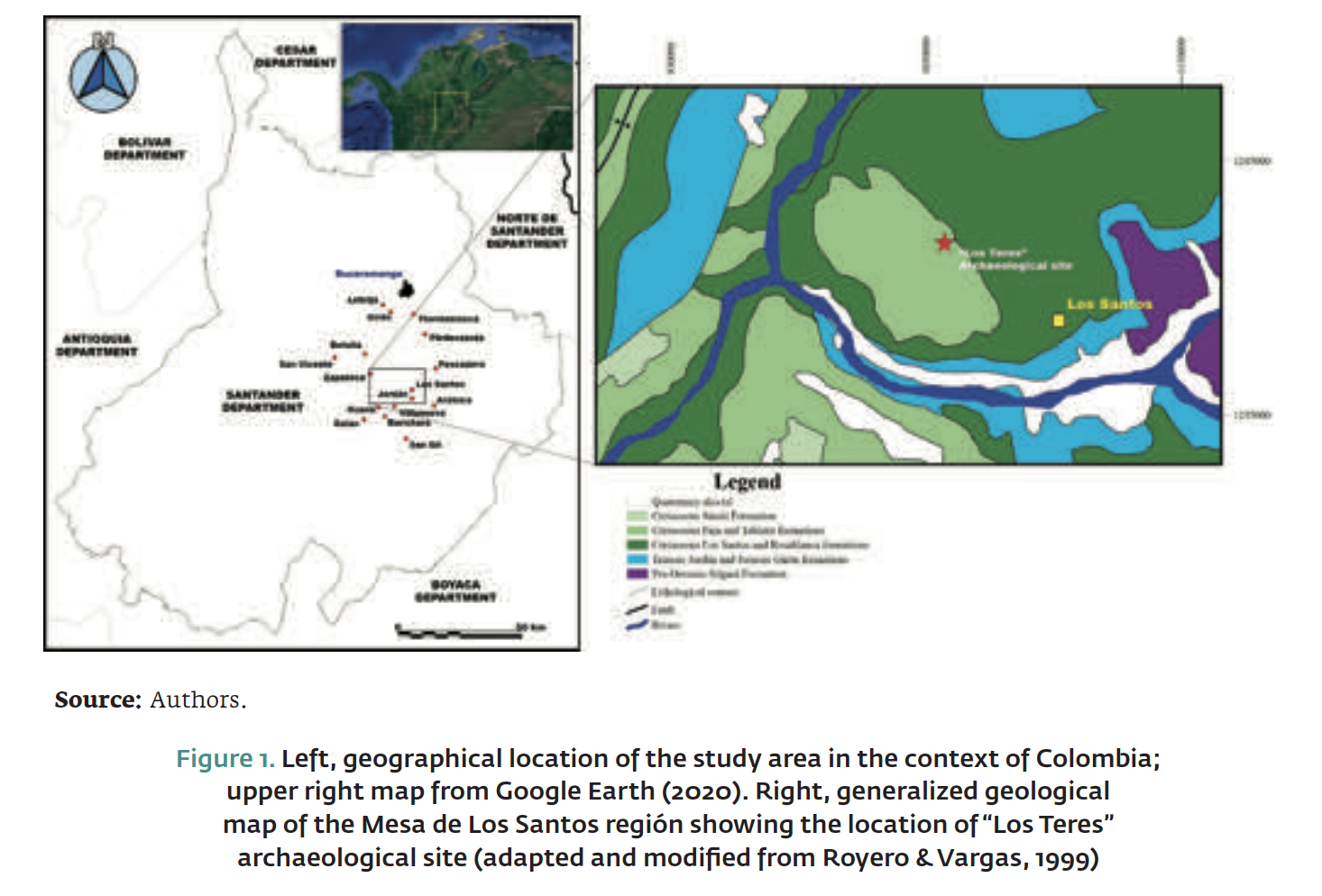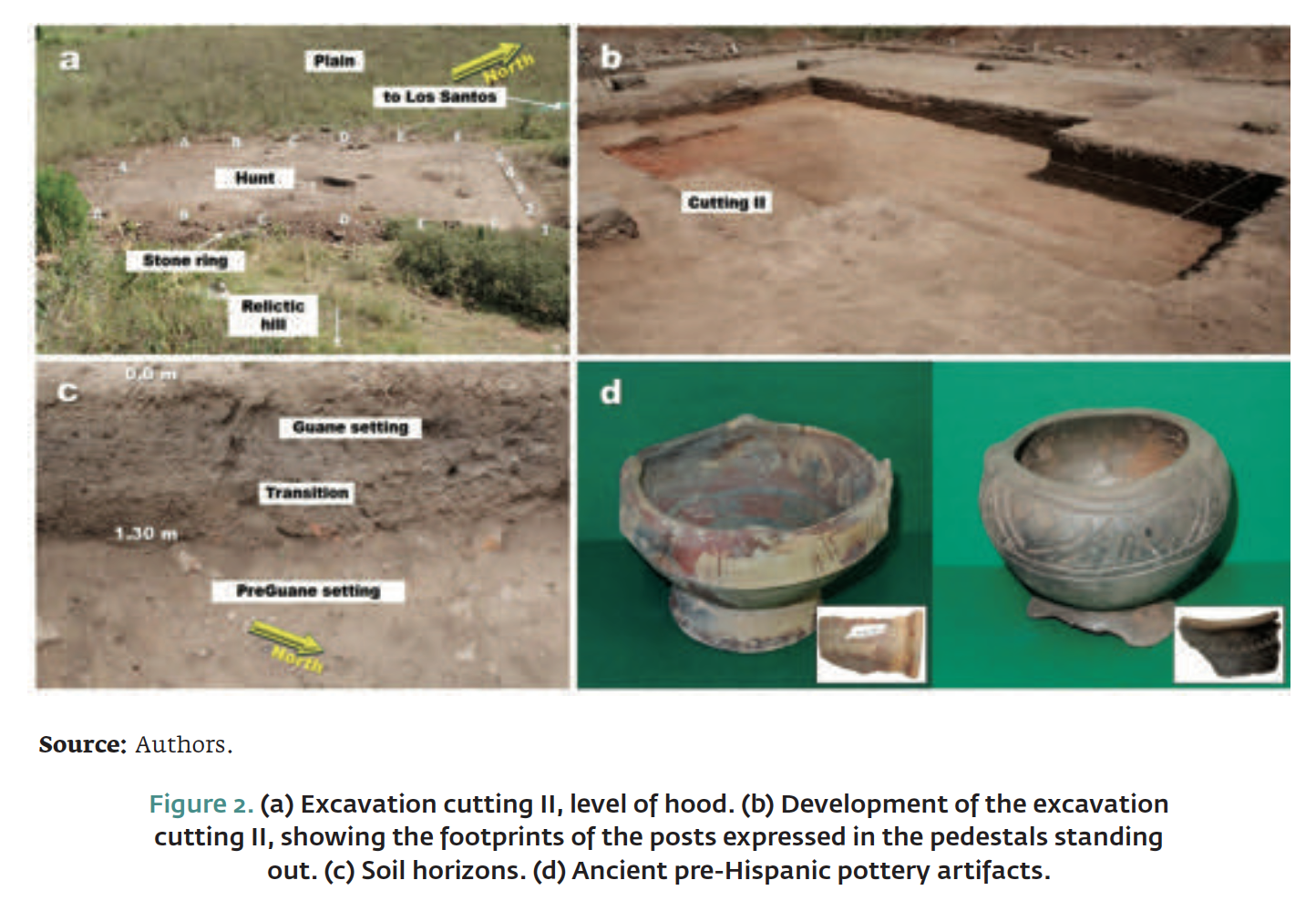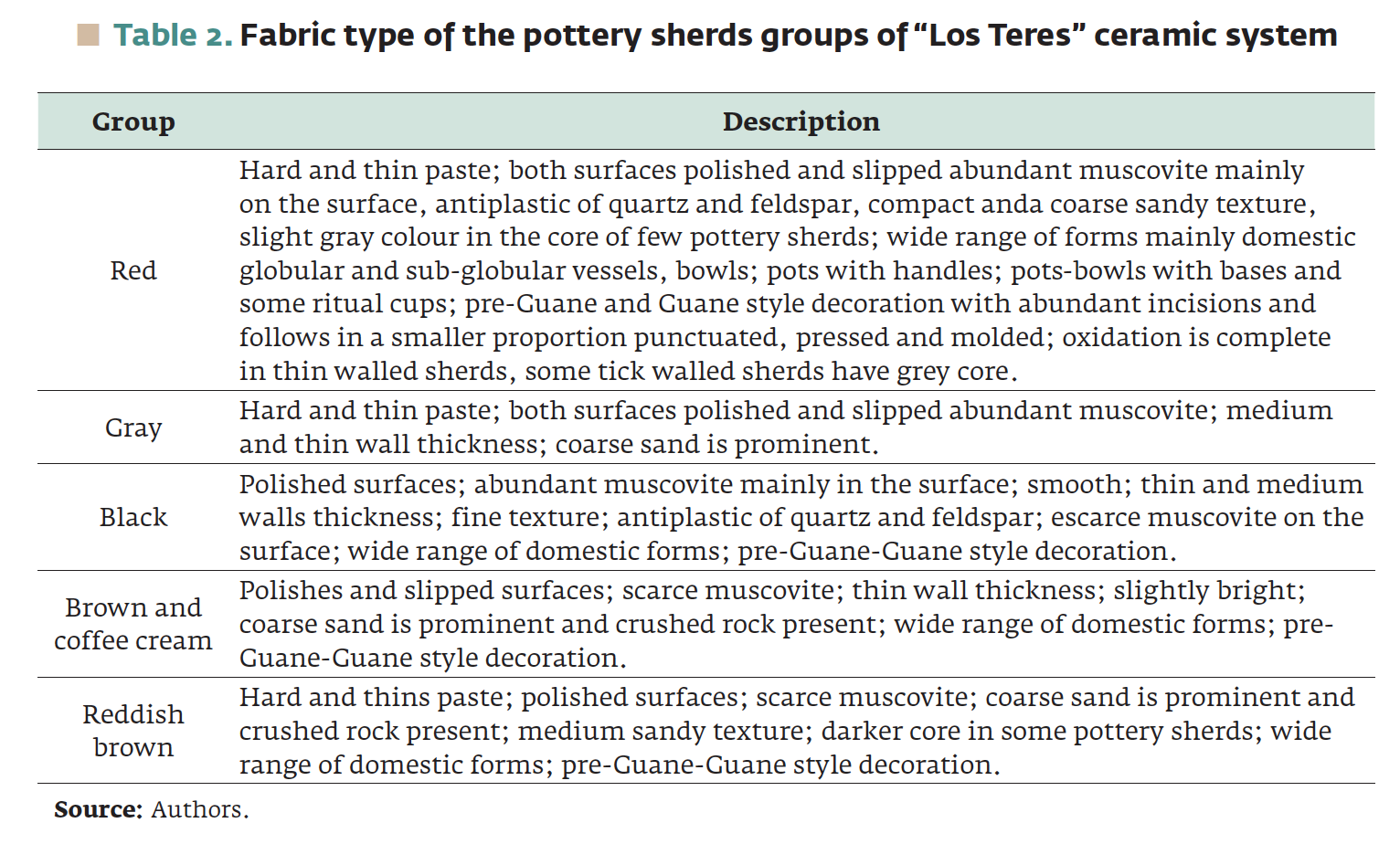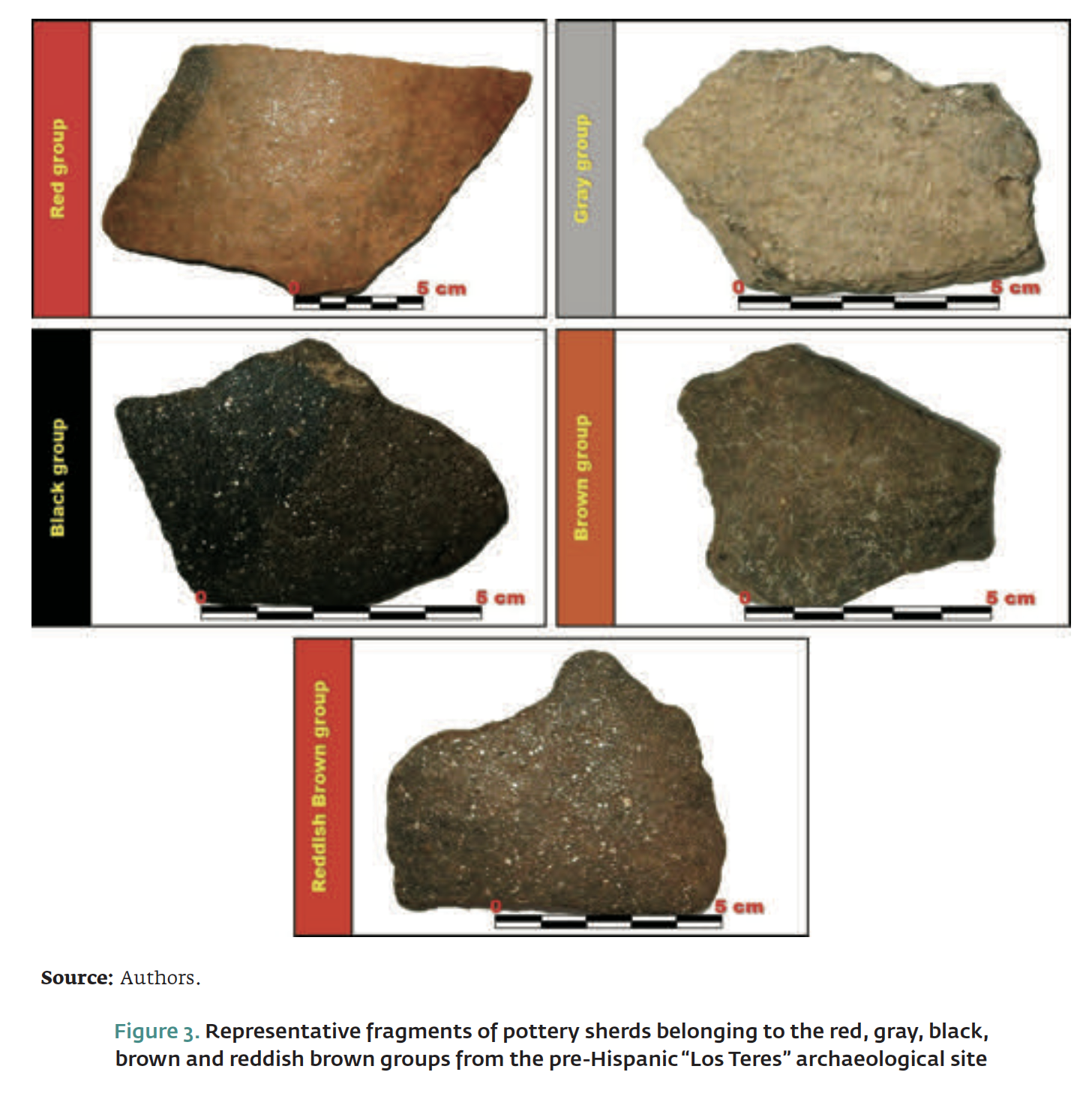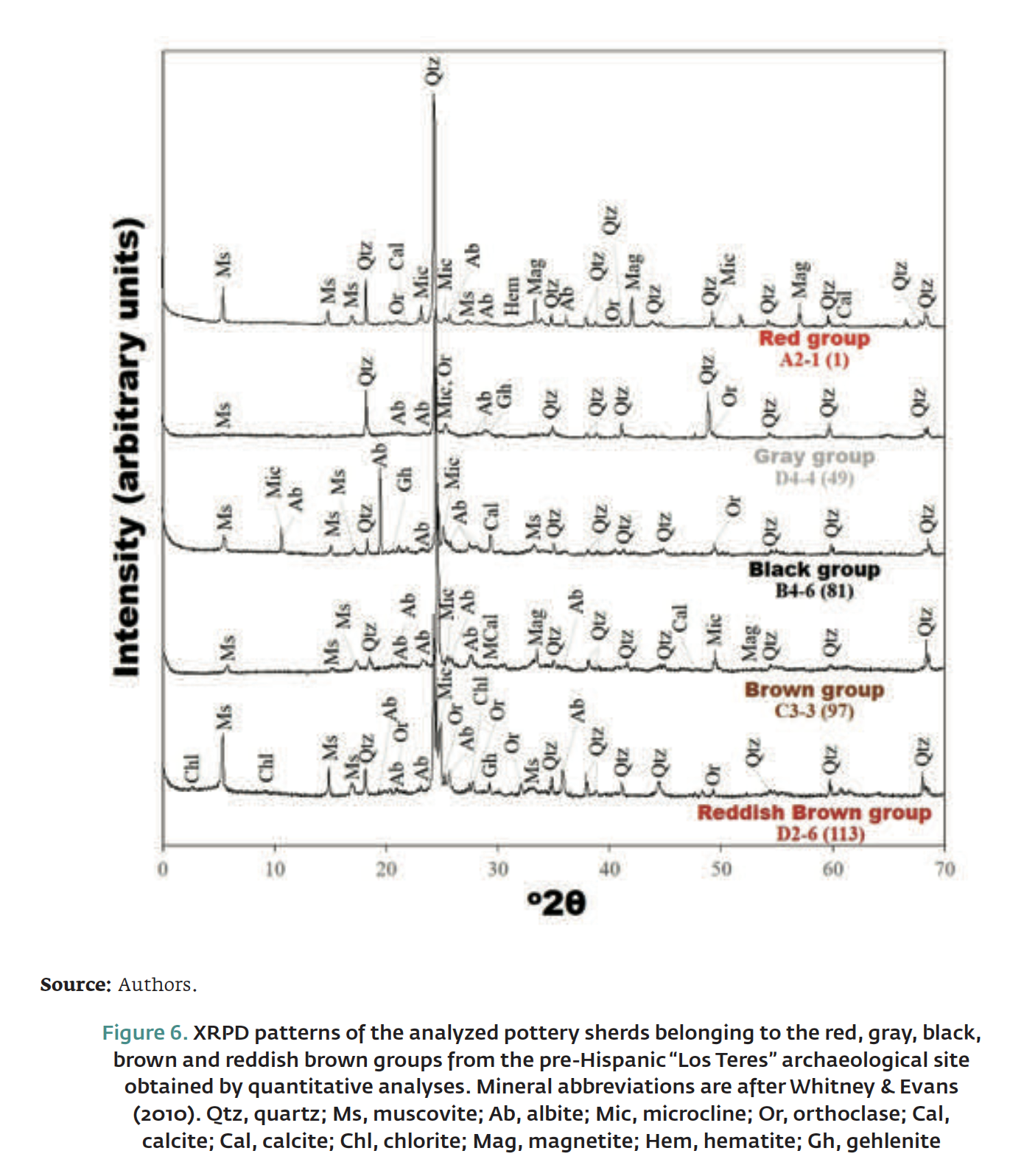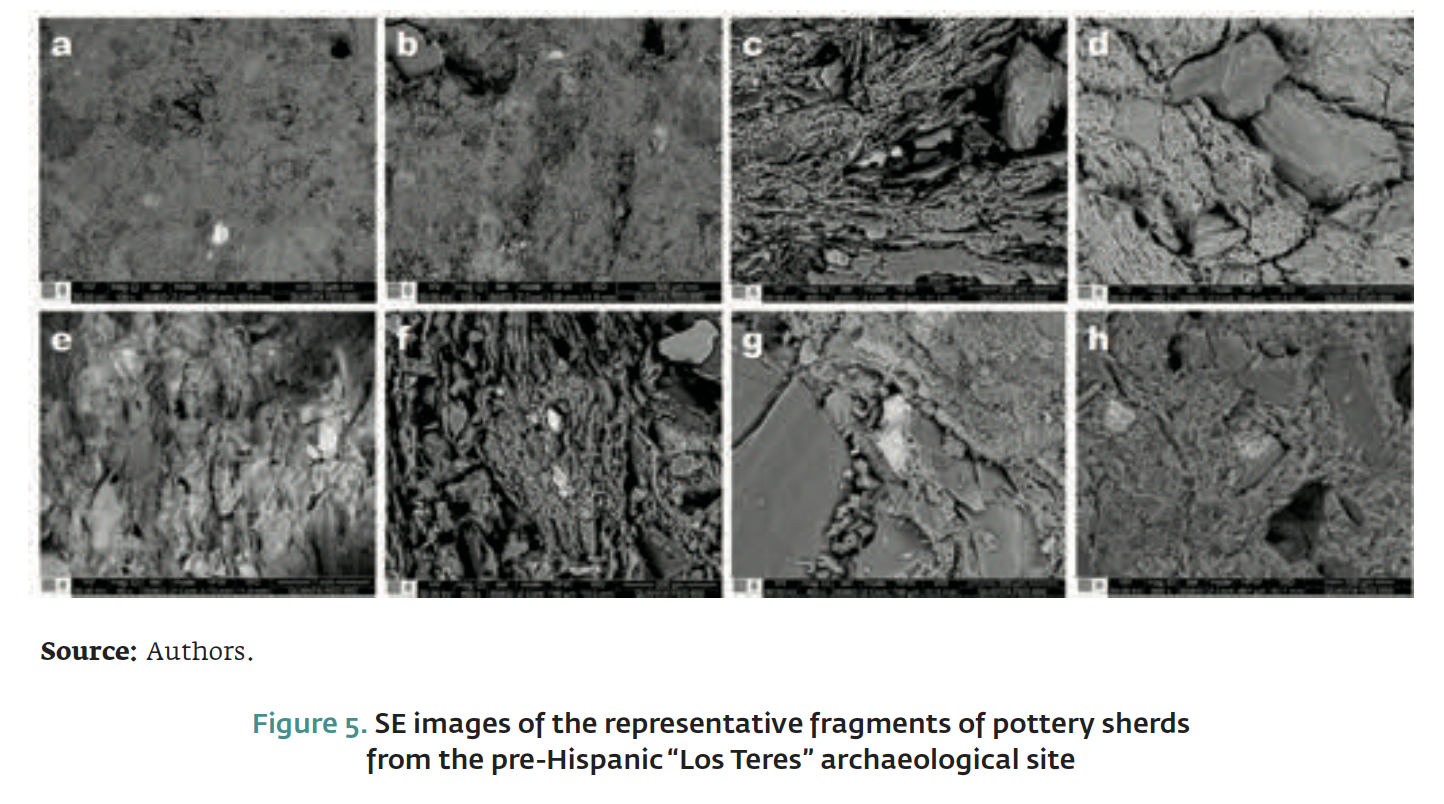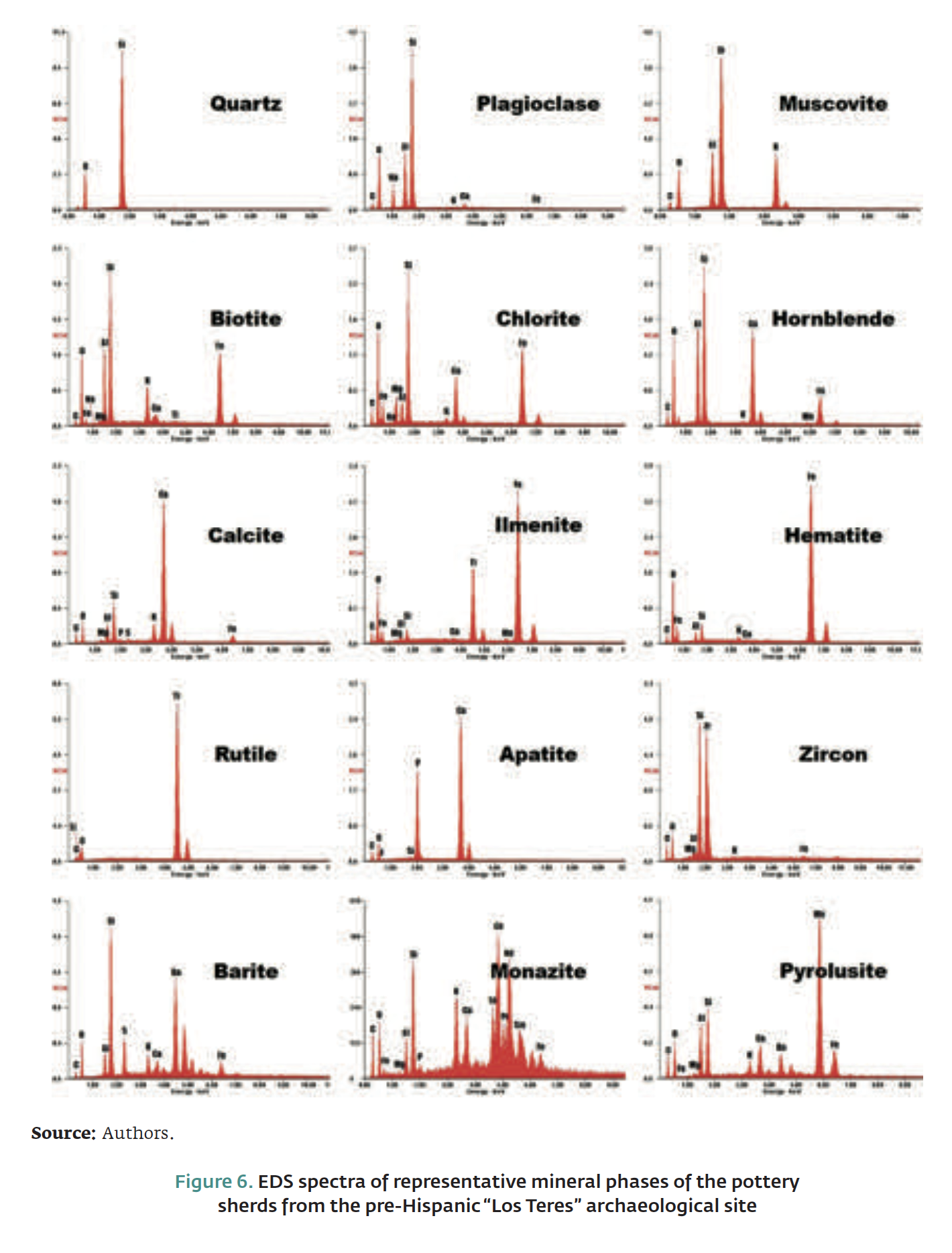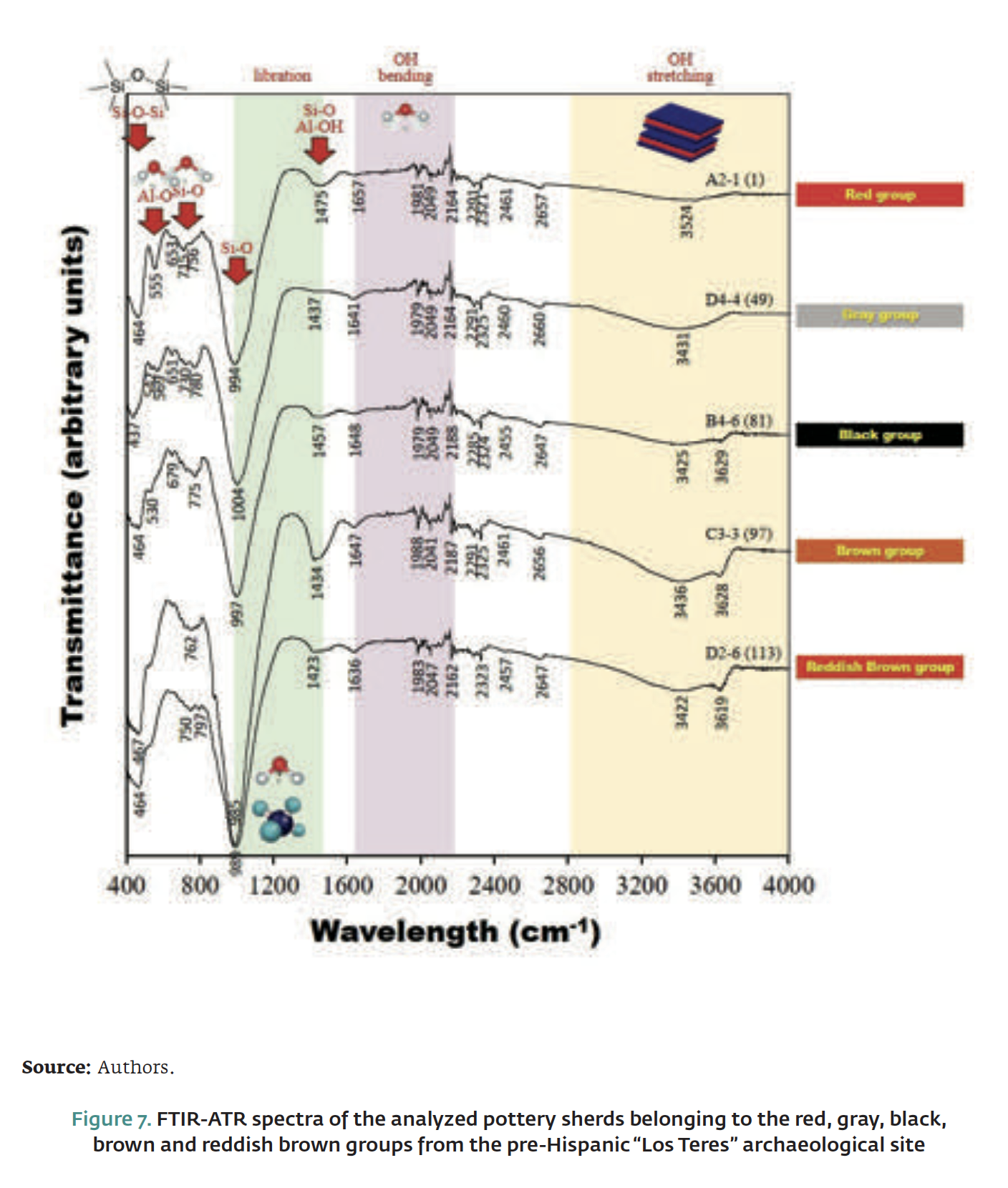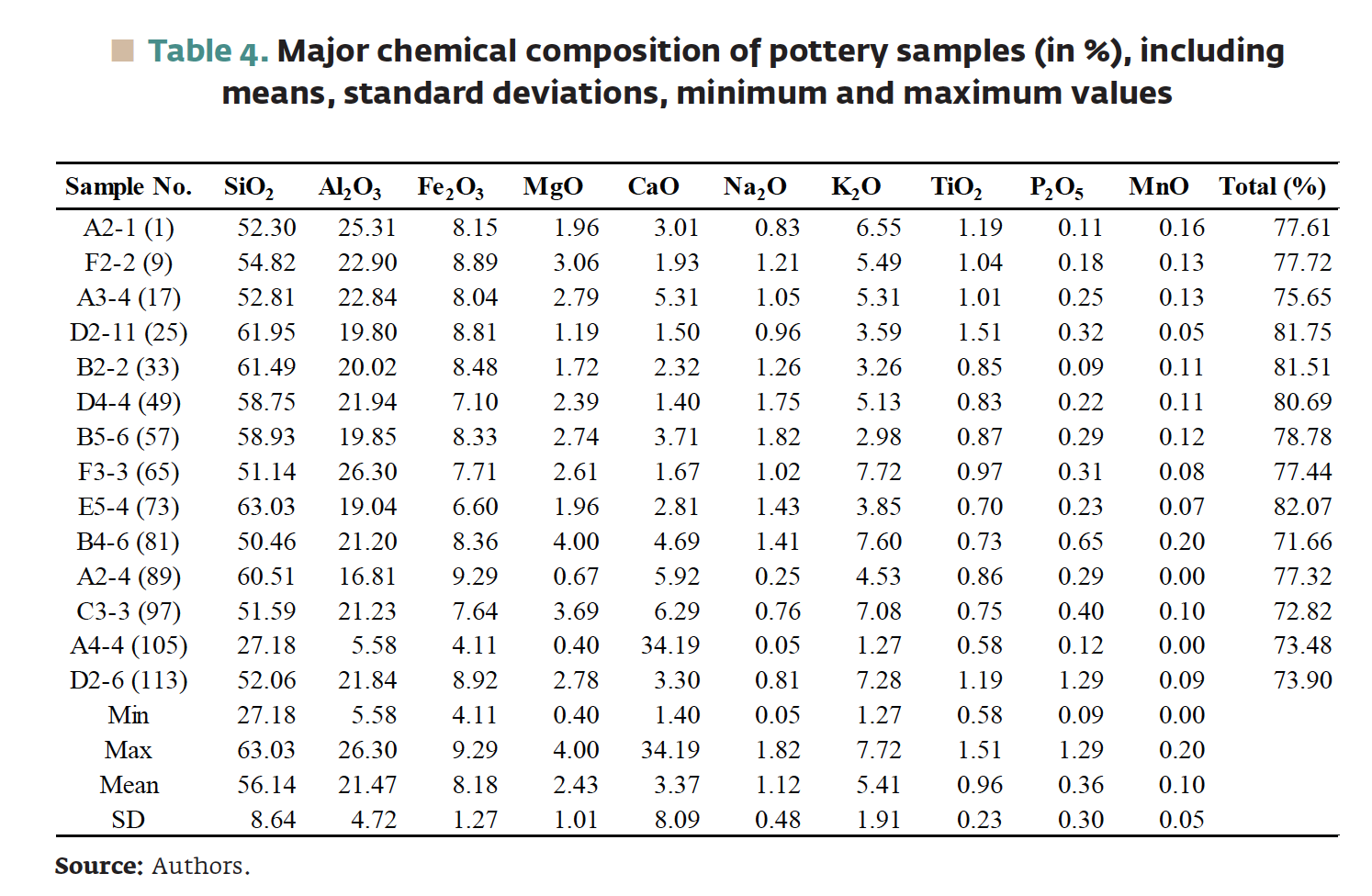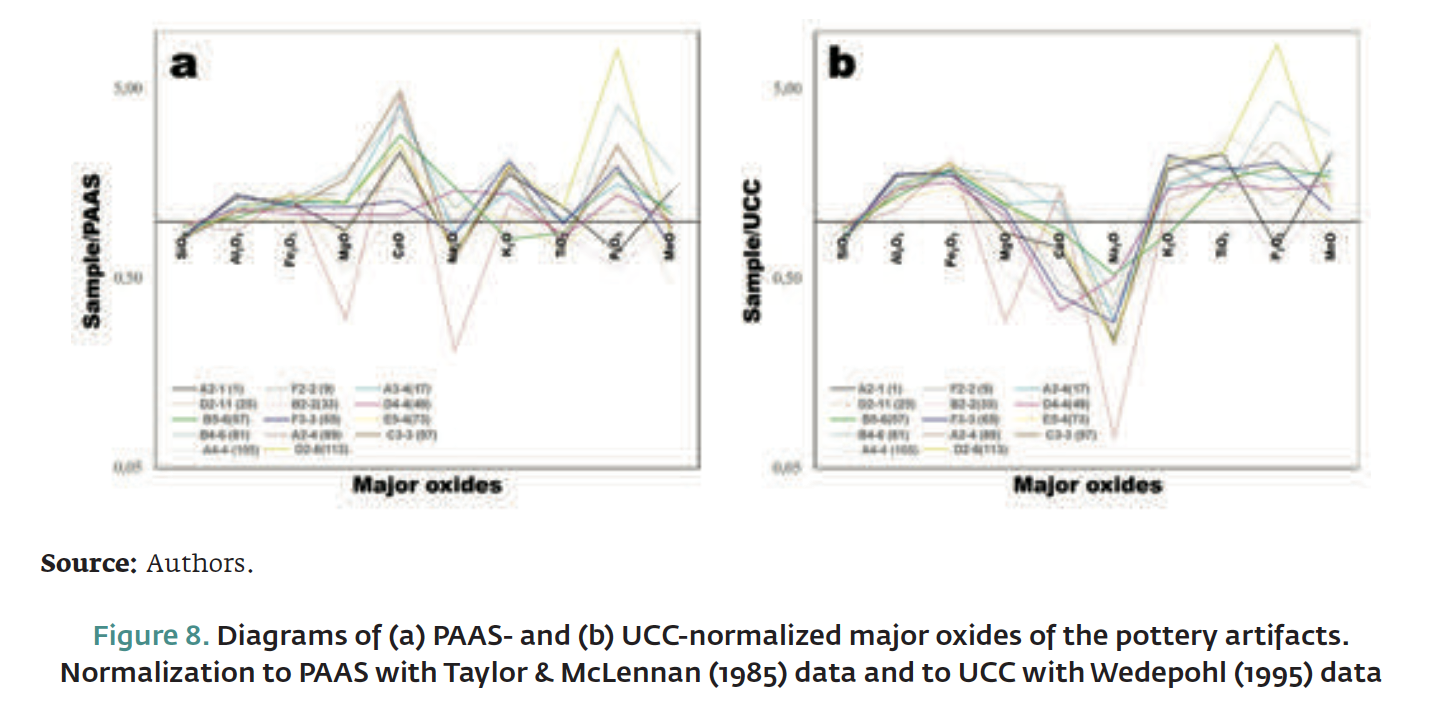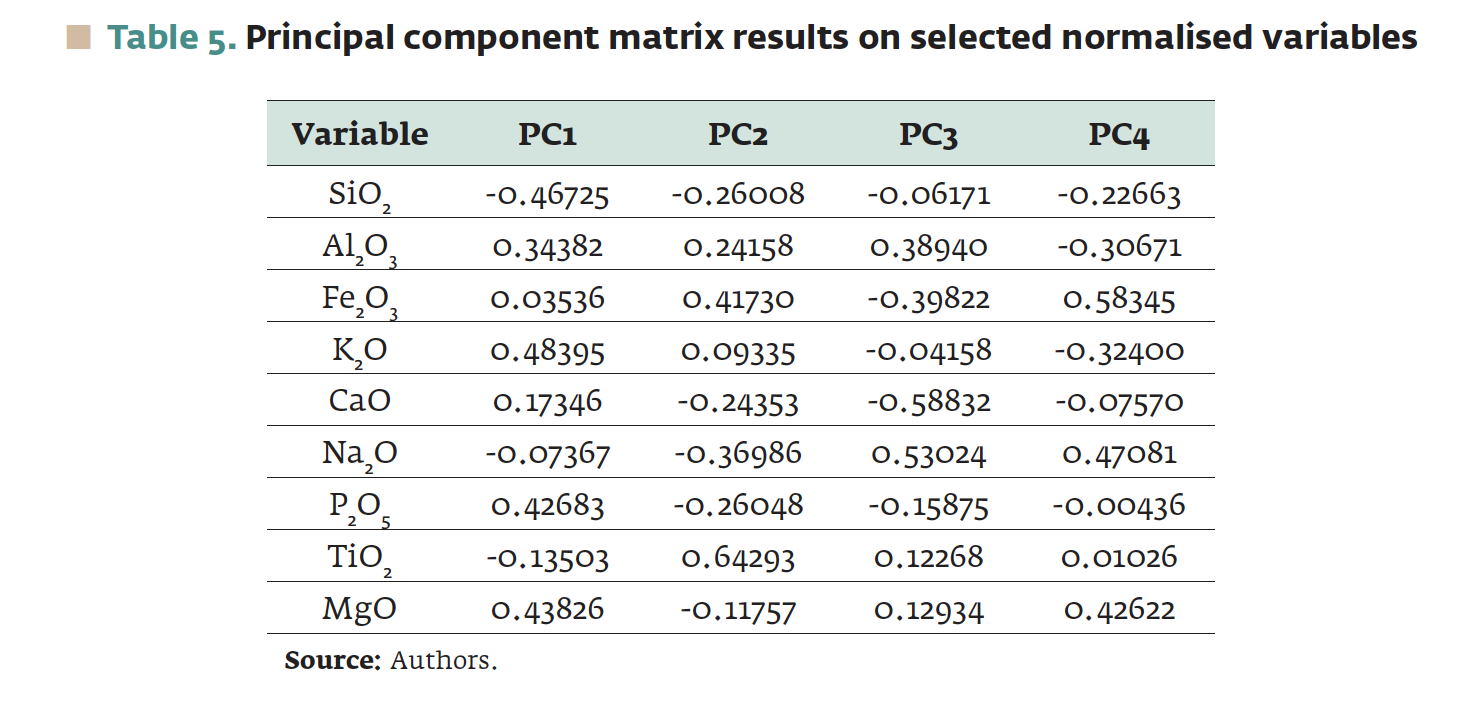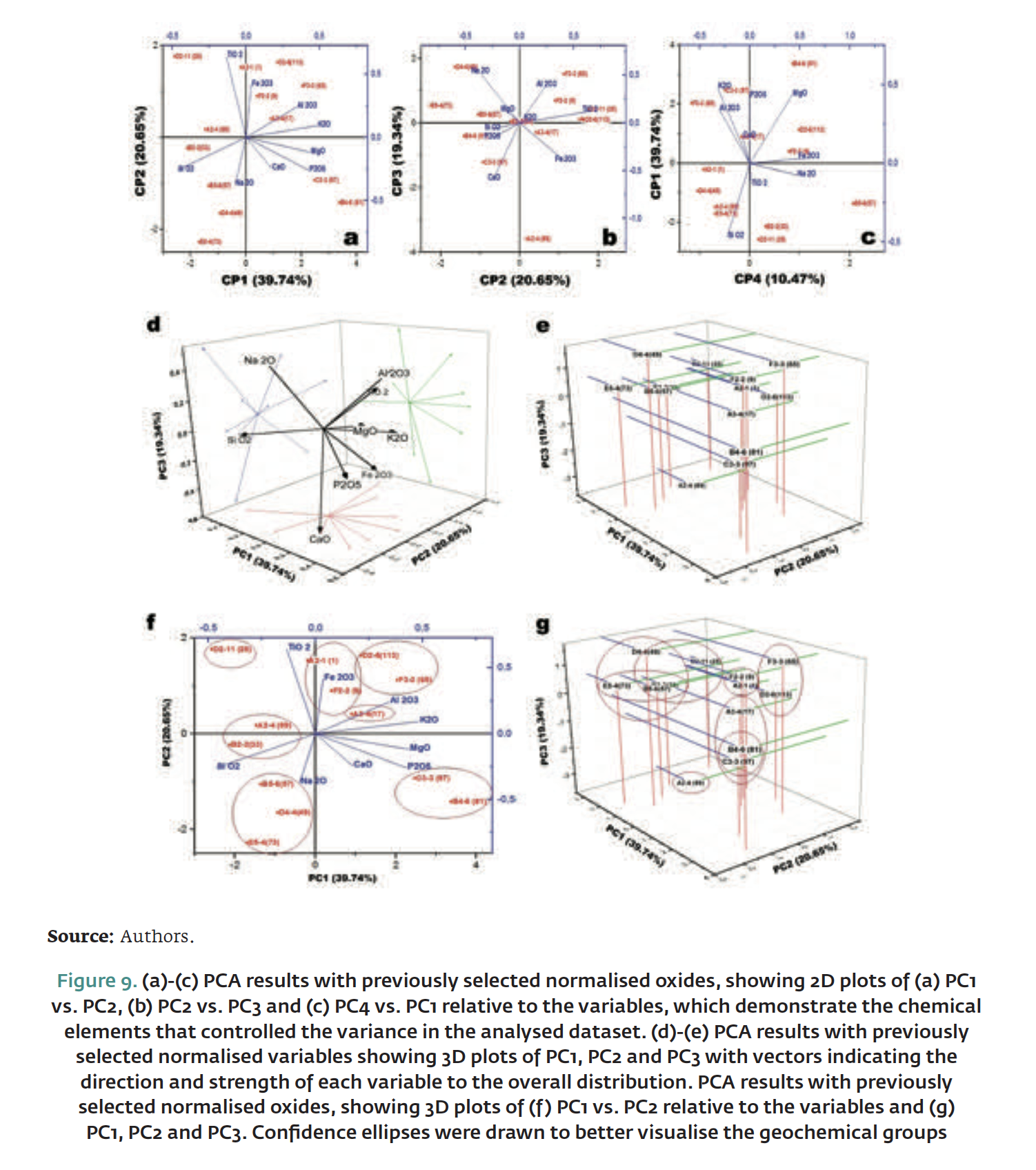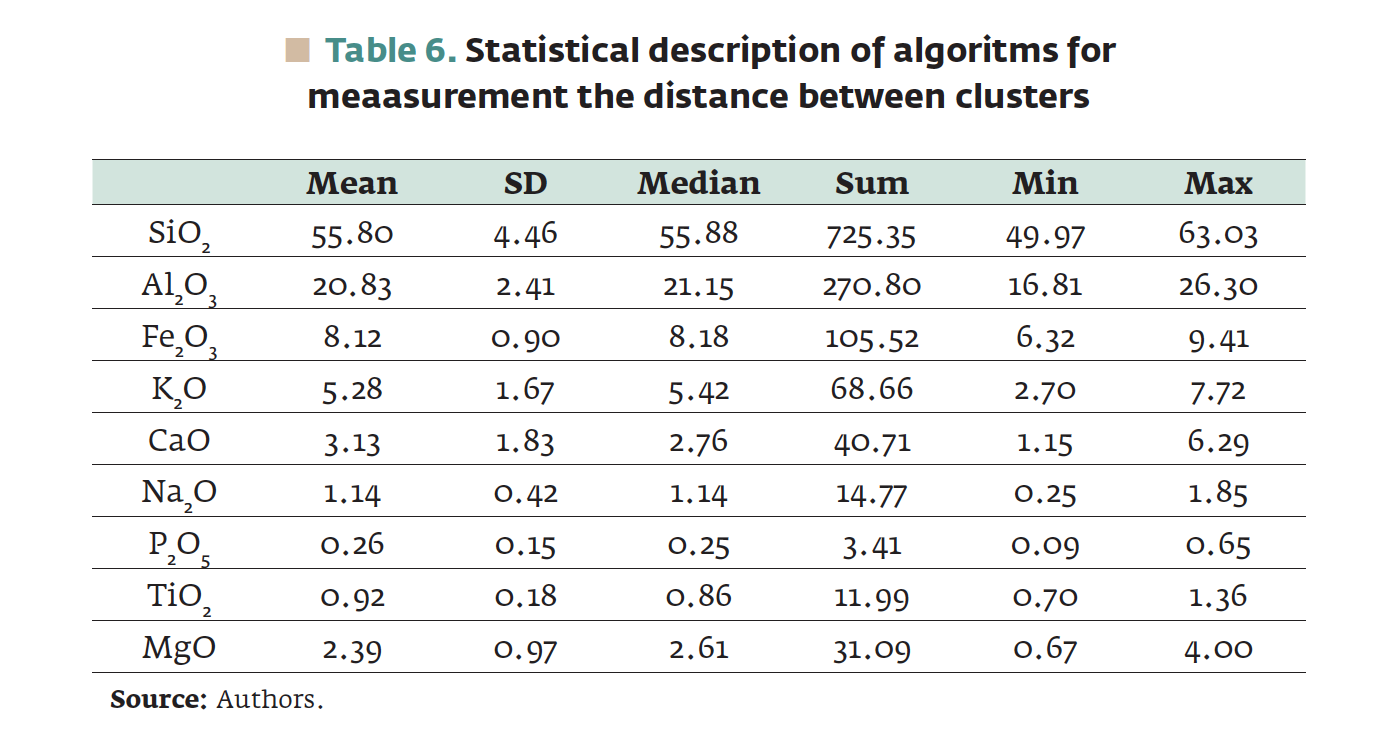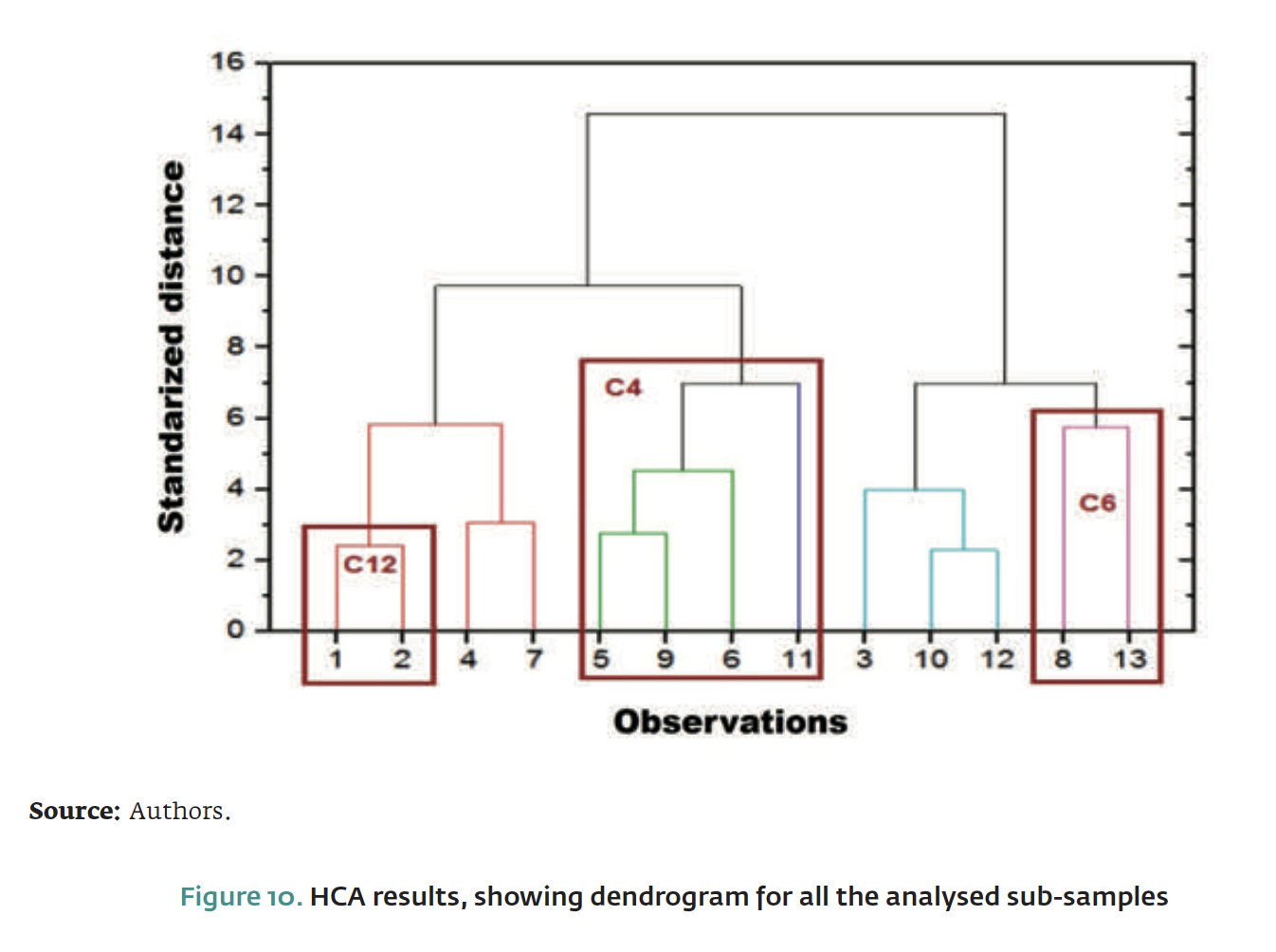Archaeometry study of the mineral and chemical composition of pre-Hispanic pottery from "Los Teres", Mesa de Los Santos (Colombia)
Estudio arqueométrico de la composición mineral y química de la cerámica pre-Hispánica de "LosTeres", Mesa de Los Santos (Colombia)
Estudo arqueométrico da composição mineral e química da cerâmica pré-Hispânica do "Los Teres", Mesa em Los Santos (Colômbia)
Karina Andrea Portilla-Mendoza
E-mail: kandreapomen@gmail.com Orcid: https://orcid.org/0000-0002-4709-8098
Diego Armando Pinzón-Núñez
E-mail: diego.pinzon9@correo.uis.edu.co Orcid: http://orcid.org/0000-0001-7258-5173
Leonardo Moreno-González
E-mail: lmoreno@uis.edu.co Orcid: http://orcid.org/0000-0002-8979-4710
Ricardo Mier-Umaña
E-mail: rimier@uis.edu.co Orcid: http://orcid.org/0000-0001-8769-8680
Carlos Alberto Ríos-Reyes
E-mail: carios@uis.edu.co Orcid: http://orcid.org/0000-0002-3508-0771
Jose Antonio Henao-Martínez
E-mail: jahenao@uis.edu.co Orcid: http://orcid.org/0000-0002-5097-5661
Citar como:
Portilla-Mendoza, K., Pinzón-Núñez, D., Moreno-González, L., Mier-Umaña, R., Ríos-Reyes, C. & Henao-Martínez, J. (2020). Archaeometry study of the mineral and chemical composition of pre-Hispanic pottery from "Los Teres", Mesa de Los Santos (Colombia). Memorias: Revista Digital de Historia y Arqueología desde el Caribe colombiano (septiembre - diciembre), 7-43.
Abstract
A set of selected fragments of pre-Hispanic pottery sherds that were excavated from the Mesa de Los Santos region's archaeological site (Colombia) were investigated by different analytical techniques and principal component and hierarchical cluster analyses. This study is very useful to understand more about the raw materials (and provenance) for ancient pottery production and their manufacturing technology. In addition to establish stratigraphic and anthropological relationships, the pottery sherds were analyzed to determine their mineralogical and chemical composition, as well as their structural characteristics using X-ray powder diffraction, wavelength dispersive X-ray fluorescence, scanning electron microscopy, and attenuated total reflectance Fourier transform infrared spectroscopy. The results indicated that the pre-Hispanic pottery sherds were manufactured using poor carbonates and iron oxide-bearing clays with no significant changes in the technology of manufacture, firing the pastes at the proper temperatures or selecting and processing the raw materials to fulfill their use. The manufacture of pre-Hispanic pottery was probably carried out using local raw materials, compatible with the regional geological context, and the archaeometric study reveals that the pre-Hispanic cultures who lived in this region hardly had access to trade of raw materials.
Keywords: Pottery sherds, Los Teres, Guane, Pre-Guane, archeometry, Mesa de Los Santos region.
Resumen
Un conjunto de fragmentos seleccionados de tiestos de cerámica pre-Hispánica que fueron excavados del sitio arqueológico de la región de la Mesa de Los Santos (Colombia) fueron investigados por diferentes técnicas analíticas y componentes principales y análisis de conglomerados jerárquicos. Este estudio es muy útil para comprender más sobre las materias primas (y procedencia) para la producción de cerámica antigua y su tecnología de fabricación. Además de establecer relaciones estratigráficas y antropológicas, se analizaron los tiestos de cerámica para determinar su composición mineralógica y química, así como sus características estructurales mediante difracción de rayos X de polvos, Fluorescencia de rayos X de dispersión por longitud de onda, microscopía electrónica de barrido y espectroscopía infrarroja con transformadas de Fourier - reflectancia total atenuada. Los resultados indicaron que los tiestos de cerámica pre-Hispánica se fabricaron utilizando arcillas pobres en carbonatos y óxidos de Fe sin cambios significativos en la tecnología de fabricación, cociendo las pastas a las temperaturas adecuadas o seleccionando y procesando las materias primas para cumplir con su uso. La fabricación de cerámica pre-Hispánica probablemente se llevó a cabo utilizando materias primas locales, compatibles con el contexto geológico regional, y el estudio arqueométrico revela que las culturas pre-Hispánicas que vivían en esta región difícilmente tuvieron acceso al comercio de materias primas.
Palabras clave: Tiestos de cerámica, Los Teres, Guane, Pre-Guane, arqueometría, región de la Mesa de los Santos.
Resumo
Um conjunto de fragmentos selecionados de sherds cerâmicos pré-Hispânicos que foram escavados no sítio arqueológico da região de Mesa de Los Santos (Colômbia) foi investigado por diferentes técnicas analíticas e componentes principais e análise hierárquica de agrupamentos. Este estudo é muito útil para entender mais sobre as matérias-primas (e proveniencia) para a produção de cerâmica antiga e sua tecnologia de fabricação. Além de estabelecer relações estratigráficas e antropológicas, os sherds cerâmicos foram analisados para determinar sua composição mineralógica e química, bem como suas características estruturais por difração de raios X em pó, fluorescencia de raios X por dispersão no comprimento de onda, microscopia eletrônica de varredura e espectroscopia no infravermelho por transformada de Fourier - refletância total atenuada. Os resulta dos indicaram que os sherds cerâmicos pré-Hispânicos foram fabricados com argilas com baixo teor de carbonato e óxidos de Fe sem alterações significativas na tecnologia de fabricação, queimando as pastas nas temperaturas apropriadas ou selecionando e processando as matérias-primas para atender seu uso. A fabricação de cerâmica pré-Hispânica provavelmente foi realizada com matérias-primas locais, compatíveis com o contexto geológico regional, e o estudo arqueométrico revela que as culturas pré-Hispânicas que viviam nessa região dificilmente tinham acesso ao comércio de matérias-primas.
Palavras-chave: Sherds cerámicos, Los Teres, Guane, Pre-Guane, arqueometría, região de Mesa de los Santos.
Introduction
Today, it is common to find discrepancies between inferences on socio-economic, cultural and historical activities, proposed by archaeologists based on their ceramic analytical results and data gathered adopting techniques in geoscience (e.g., Papachristodoulou et al., 2006; Belfiore et al., 2007; Barrios-Neira et al., 2009). Places of residence, as well as lithic and ceramic technologies, as human responses of the past, constitute a valuable source of information to study the lifestyle and socio-cultural activity of past societies and their relationship with the environment. The study of ceramic artifacts allows us to make inferences about social activity and modus of life in the past. In this context, ceramic technology has been a reference in archaeological studies to compare different societies of the past and even consider relations of cultural and commercial exchange between continents (e.g., Kramar et al., 2012; Municchia et al., 2016). In the Americas, the earliest ceramics known have been dated to 9500-5000 years ago (Roosevelt, 1996), which as archaeological products represent the greatest evidence of agro-pottery societies of the past. Due to the abundance and durability of ceramics, it is one of the most common types of artifacts found by archaeologists during excavations. The scientific work on archaeological ceramics based on the examination of the shape, style, color and decoration has generated valuable information on their typologies, forms and functionalities defined by archaeologists, supported by chronology and places of origin (Papachristodoulou et al., 2006). It reveals subsistence strategies drawn by communities of the past according to their material and social needs and the matrix of resources found in their residential environment. Nowadays, various instrumental analytical techniques are routinely applied to the study of ancient ceramics that allow investigating ever more deeply into the frequently unsolved problems of their origin, manufacture and lifecycle (Noll and Heimann, 2016). These techniques include "classic" analytical tools, such as elemental chemical analysis and X-ray fluorescence spectroscopy to determine the chemical composition of ceramics, X-ray diffraction to obtain their phase composition (e.g., Velraj et al., 2015), scanning electron microscopy to obtain information on texture, microstructure and topography of ceramic bodies and paint layers (e.g., Damjanovic et al., 2014; Velraj et al., 2015), electron microprobe analysis for determining the chemistry of the constituent minerals (e.g., Bong et al., 2010; Ionescu et al., 2011), infrared and Raman spectroscopy for the detection of organic residues in archaeological materials (e.g., Goodall et al., 2007; Lucas et al., 2018), high-resolution X-ray microtomography to carry out the characterisation of the connectivity within the porous system and the analysis of the orientation of the pore structures (e.g., Kahl & Ramminger, 2012) and gas chromatography-mass spectroscopy for analying any substance containing volatile organic compounds (e.g., Regert, 2011). Archaeological analysis of pre-Hispanic ceramic technology and its socio-economic, cultural and historical scope, contrasted with data from geosciences, in addition to its documentation value allows qualifying archaeological inferences based on the understanding of the attributes of the raw materials used for the manufacture of ceramic artifacts (e.g., Kramar et al., 2012; Ravisankar et al., 2014) and the technology involved in the manufacturing process (e.g., Belfiore et al., 2010). This may reveal significant information about the provenance of the raw materials with which the ceramic artifacts were manufactured (e.g., Sherriff et al., 2002). The presence or absence of certain mineral phases provides information regarding the firing conditions in terms of both temperature and atmosphere used during pottery production (Iordanidis et al., 2009).
In the framework of the archaeological problems of northeastern Colombia, a first approximation is necessary on general aspects such as social evolution, population dynamics, social change, subsistence responses and strategies, and sources of supply of raw materials to manufacture ceramic utensils and stone tools. For this approach, previous studies (e.g., Giraldo-Jaramillo, 1941; Such-Martin, 1945; Jiménez, 1945; Sutherland, 1972; Morales and Cadavid, 1984; Cifuetes, 1989; Lleras and Vargas, 1990; Gómez and Cuervo, 2012; Moreno-González, 2012a, 2012b, 2013; Portilla-Mendoza et al., 2019) have been developed to study the housing sites, the presence and distribution of ceramic (clay pots) and lithic material, the stratigraphic context and the support of dates from C14, the classification and determination of the characteristics of the ceramic groups that make up the pottery systems of the archeological cultures pre-Guane (IV-XII centuries, A.D.) and Guane (XIII-XVI centuries, A.D.).
Within the framework of these aspects, the main aim of this work focused on the study of ceramics and the determination of sources of supply of raw materials to manufacture ceramic products. The following specific objectives were considered: (1) to evaluate the relationship between the composition of different pastes in ceramic sherds and estimate possible ranges of firing temperatures by paste type, and (2) to evaluate the hypothesis that the clay pots that make up the ceramic system of "Los Teres" archaeological site, were made only using local raw clays. These objectives are associated to the following archaeological questions related to the processes of occupation of the territory (autochthonous or foreign populations), the different sources of supply and the socio-productive dynamics related to the production of ceramic objects: (1) were there two different societies or cultures in the Mesa de Los Santos region?; (2) were two different ceramic systems developed?; (3) was there a flow of ceramic exchange in the region of northeastern Colombia?; (4) was there just a use of local raw clays for the manufacture of ceramic objects?. To answer these concerns, a representative set of pre-Hispanic ceramic fragments and the mineral and chemical composition of pottery sherds produced by the potters of the pre-Hispanic "Los Teres" archaeological site in order to suggest the type of raw clay used for the manufacture of ceramic objects, and, therefore, their provenence.
In this work, the study ceramic production, the mineralogical composition of pastes and sources of raw material supply, contribute to knowledge of the archeology in the northeastern Colombia, related to settlement patterns, pottery production, the possible exchange of ceramic products at the regional level, changes in pottery and social life in the past, all involved in the so-called problem of pre-Hispanic cultures known as pre-Guane and Guane.
Geological setting
The archaeological site of "Los Teres" is located in the Mesa de Los Santos region, Colombia (Figure 1). In order to suggest the possible provenance of the raw materials used for the production, a brief description of the geological framework may be useful. In the regional geological context, the Mesa de Los Santos region is limited by the NW trending Bucaramanga Fault on the east that separates it from the Santander Massif and the NE- to NW-trending Suarez Fault that separates it from the Zapatoca region. The Mesa de Los Santos is characterized by a flat surface, which represents a relic structural surface of an old structural platform of tabular morphology that was dissected by the Suarez, Chicamocha, Sogamoso, Río de Oro and Lebrija rivers.
The geology of this region has been extensively studied by different authors (e.g., Julivert, 1958; Ward et al., 1973; Diederix et al., 2009; Díaz et al., 2009; Caballero et al., 2010; Velandia, 2017) since the 1930s. The pioneer geologic study of the Mesa de Los Santos region was undertaken by Julivert (1958), in which a structural characterization and morphostructural evolution is carried out as well as its geological cartography. Later, INGEOMINAS (1985) publishes a special edition of the Cretaceous Project which contains a sedimentological and tectonic analysis of the Cretaceous units. Díaz & Suárez (1998) establish a relationship between the System of Fallas del Suárez and Bucaramanga, where a statistical analysis of diaclases taken in different geological formations is carried out. Recently, hy-drogeological studies (e.g., Contreras, 2008; Díaz et al., 2009) have been carried out in this region, emphasizing the analysis of the fracturing of outcropping geological units and their hydrogeological potential. In the Mesa de Los Santos region, metamorphic rocks of low to medium degree of the Silgará Formation of Paleozoic age and intrusive igneous rocks of the Pescadero Granite of Jurassic age, which are discordantly overlaid by continental sedimentary rocks of the Jordán and Girón formations of Jurassic age, which in turn are discordantly overlaid by sedimentary rocks of the Los Santos, Rosablanca, Paja and Tablazo formations of Cretaceous age and unconsolidated Quaternary deposits. In the archaeological site, black and micaceous clayey to silty shales, slightly calcareous and thinly laminated, with thin gypsum lamellae and fossiliferous and occasionally pyritic concretions of the Cretaceous Paja Formation occur.
Archaeological context
The Guane culture represents aboriginal societies that inhabited the region of the Mesa de Los Santos around the pre-Hispanic period in the XIII century, A.D. The Guanes are considered to have been chiefdoms, with characteristic architectures anchored on two fundamental pillars (Moreno-González, 2012a, 2012b, 2013). The excavation site, where Morales & Cadavid (1984) discovered pre-Hispanic houses, is located in "Los Teres" village between northern latitude 06°4s'18.8" and eastern longitude 73°07'16.7'', Mesa de Los Santos region, Colombia (Figure 1). The greatest usefulness of the ceramic typological classification is its instrumentation as an archaeological trait indicating cultural affiliation and social activity, spatial-territorial relations and as a material element to compare archaeological evidence, at different times of occupation in the past depending on their technical and formal features. In the classifications of archaeological products, it is important to highlight that the concept of "pottery sherd", which refers in this study to baked and processed clay with degreasing materials that were added to improve the resistance in crude and shrinkage of the pasta and withstand temperature changes during cooking. Degreasers that were likely used in the manufacture of the investigated pots include claystones, sandstones, granite rocks, baked clay pot dust, organic debris, crushed bones, etc. Portilla-Mendoza et al. (2019) tried to assess the bath or slip and mineralogical matrix of the paste and the intentional application of the degreaser, to determine the ceramic systems of "Los Teres" archaeological site, formed by groups (defined by the color of the surface on its external face) and units (determined by the color of the internal face). As will be discussed later, the present study reveals that the analyzed posts show a homogeneous mineralogical composition, despite the variation of its chemical composition. However, factors such as shape, size or decoration evaluated to affirm that ceramics did not show significant variations are the object of research by archaeologists and, therefore, this is beyond the scope of this study. Archaeologists are the ones who have determined two different cultures that coexisted during the pre-Guane - Guane transition period (from 12th to 13th centuries, A.D.) based on the factors noted above.
The pre-Hispanic pottery of interest in this study correspond to different pottery groups defined by archaeologists and, according to the archaeological chronology (Table 1), they belong to the pre-Guane (IV-XII centuries, A.D.) and Guane (XIII-XVI centuries, A.D.). The chronological typology proposed by Lleras & Vargas (1990) allows the same ceramic types to be involved in different activities of social life (depending on the context, whether housing or tombs etc.). It is supported by stratigraphy, leading them to infer that in the dynamics of settlement at the regional level, there are important cultural aspects, related to a context of pre-Guane-Guane historical continuity, with their respective social changes over time.
The archaeological context allows to explain human occupations, historical and social change relations between groups and territories and deal with social and cultural aspects or ways of life in space and time. The archeological excavation was performed between 2011 and 2012, and numerous pottery sherds with varied size and style were recovered in a trench (excavation cut II) of 12x10 m2, which was divided into 30 grids of 2x2 m2, identified with an alphanumeric code (from A to F in the southeast direction, and from 1 to s in the southwest direction), following a coordinate plane adjusted to the geographical north (Figures 2a-2b), and depth of 1.3 m from the surface at the site location. The excavation was developed in several levels (Figure 2c): level 1 of 0-20 cm (relatively larger due to the action of tractors), and from level 2 of 20-30 cm to level 11 of 120-130 cm, descending every 10 cm. Each level is indicated on the ceramic artifacts with a number at the end and the grid in which they were recovered is related to the letter accompanied by the number.
of reddish brown color with iron oxidation traces reaching a depth of 10s cm, which however can change towards the south-east side of the excavation due to the occurrence of outcrops of the parental rock. The ancient pottery artifacts (Figure 2d) recovered were treated conventionally for removing the dirt and stain and categorized. Fourtheen samples were selected at random as representative samples for the present study. Archeologists classified the recovered samples as ancient pottery artifacts manufactured by the pre-Guane and Guane culture. "Los Teres" is a significant area in archaeological terms which has been studied extensively due to the numerous evidences of settlement sites and the numerous manifestations of funerary architecture.
Moreno-González (2012b) describe and discuss in detail the ceramic typologies. In general, the ceramic pieces did not show significant variations with respect to the level of depth in which they were found, which suggests, together with other evidences, that these societies did not make significant changes in the manufacturing technology of the ceramic artifacts over the centuries.
Materials and methods
Description of the pottery fragments
A total of 14 pottery fragments were selected from the excavation site for this study, taking into account that sampling represented the diversity observed macroscopically among pottery fabric, surface and decoration and is proportional to the number of pottery sherds identified in each category of the ceramic system of classification proposed by Moreno-Gonzalez (2012, following Morales & Cadavid (1984)).
The pre-Hispanic pottery fragments from "Los Teres" archaeological site were classified in groups encompassing the two ceramic systems determined, one of the pre-Guane system whose socio-cultural activity was present from the iv to XII centuries, A.D. and the Guane ceramic system, whose evidence materializes from the XIII to XVI centuries, A.D. (e.g., Moreno-González, 2012a, 2013). The most outstanding features of the pottery in both systems, are marked by the forms and especially the presence of vessels: globular, subglobular, composite silhouette and bowls pots with ring bases, decorated with incised techniques, appliques as small circular protuberances and pressed triangular (pre-Guane) and large pots with simple and double handles, jugs and bowls, highlighting the decoration painted with zonal stripes, horizontal and vertical bands on the neck and, sometimes, a line painted near the lip (Guane) as shown in Table 2.
Mineral and chemical characterization
Archaeological pottery sherds were characterized by the scientific techniques described below. Bulk mineralogical composition was determined via x-ray powder diffraction (xrpd) using a bruker D8 advance x-ray diffractometer equipped with operating in Da Vinci geometry and equipped with an x-ray tube (Cu-Ka1 radiation: A = 1.5406 A). Microtexture and chemical composition of pottery sherds were examined using scanning electron microscopy (sem) by using back-scattered electron (bse) imaging and eds analysis on a fei quanta 650 feg-esem. Broken fresh surfaces in cross sections of sample chips were used, taking into account that polished surfaces may exhibit pore morphology, although they lose a large amount of texture and structure because these surfaces mask the nature of the pores. Sample chips were carbon coated using a Quorum Q150R ES - Rotary Pumped Coater to enable or improve the imaging of samples. Structural characterization from the functional groups were conducted by attenuated total reflectance Fourier transform infrared (ftir-atr) spectroscopy, using a computer model Thermo scientific IS50, with diamond crystal in the spectral range 400-4000 cm-1. Elemental characterization of the pottery samples was performed by wavelength dispersive x-ray fluorescence (wdxrf), using a 4 kw mark bruker model S8 tiger equipped with a Rhodium (Rh) tube, a flow detector and another Interchangeable scintillation, collimators and analyzer crystals used to avoid overlaps between various lines and increase the sensitivity of the instrument. The selected specimen from the sample was ground in an agate mortar and subsequently sieved to a particle size of less than 38 m|i. Then, the sample powder (10.0 g), with binding agent (1.0 g of binder - Licowax PE190), was compressed in order to get a solid tablet of powder (pellet) with a Herzog htp hydraulic press with 280 kN pressure for 20 s into aluminum cups. Subsequently, the pellet was calcined to 950° C for 5 h with a heating rate of 200 °C/h for the determination of losses due to ignition (L.O.I). The calcined sample was ground again and then added in a sample holder (34 mm diameter plastic cup) for its respective measurement. The spectra and concentrations obtained were analyzed using the quant-express software and the Fundamental Parameters method whose detection limits per element reach concentrations of mg / Kg in mineral samples. To identify distinct grouping of investigated pottery samples, hierarchical cluster analysis was applied using Ward>s method and squared Euclidean distance. The basic statistical parameters for each element and the calculations mentioned above were computed using the statistical software programme Statistica VI.
Results
Stereomicroscopy
Figure 3 illustrates the pottery fragments of the pre-Hispanic "Los Teres" archaeological site, which were selected for this study based on the principle of representativeness in which an attempt was made to cover the diversity of colors and pottery fabrics observed in the entire ceramic system proposed for "Los Teres". Portilla-Mendoza et al. (2019) carried out a preliminary visual inspection of the pottery surfaces through stereomicroscopy to distinguish the residues from the pottery material and optimize the sampling of the as-received pottery sherds. The observation of pottery sherds under the stereomicroscope, allowed identifying 5 main ceramic groups: red, gray, black, brown and reddish brown groups (Table 2). The classification of these ceramic groups was based on visual characteristics, including the external and internal color, surface treatment (presence or absence of engobe), polishing, mineral content, size and density in the paste and the occurrence of a high amount of visible muscovite in the pottery sherd.
X-ray powder diffraction
Mineral phases identified in the analyzed ceramic groups are albite, quartz, microcline, orthoclase, sanidine and plagioclase, clay minerals, micas, carbonate minerals, and iron oxides (Table 3). It is striking the presence of muscovite in all ceramic groups, which were cataloged by archaeologists as without mica. Traces of hematite can cause a vivid orange colour of the pottery sherds, which implies an oxidizing firing atmosphere, whereas samples do not contain hematite suggest a low firing temperature (Kramar et al., 2012). The presence of magnetite revels that it was formed under reducing conditions (Sciau, 2016). Data reveals that (1) the crystalline phases range from 56.40 to 69.70% and the amorphous phases range from 30.30 to 43.60% and (2) the scarce occurrence of clay minerals (kaolinite) in the analyzed pottery sherds.
The mineralogy also did not show a clear relationship with the colors expressed by the potter system; in this regard it should be noted that the presence or absence of muscovite, before taken together with the colors present on the external surface of the ceramic as the only indicators in the system of classification of ancient ceramics proposed for "Los Teres" archaeological site should not be taken as an indicator, since the difference lies in the contents of muscovite in the analyzed pottery sherds.
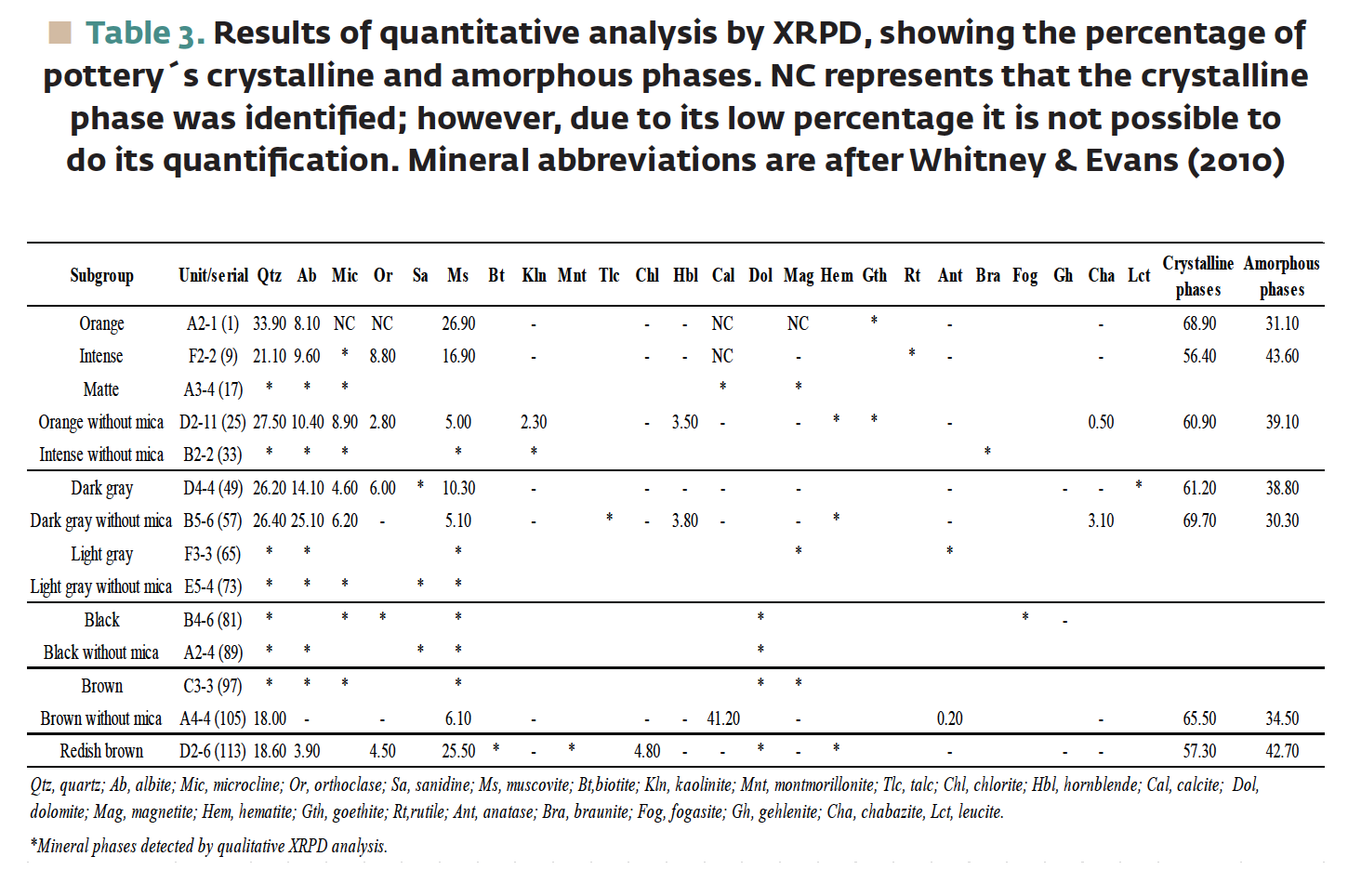
Figure 6 illustrates the XRPD patterns of the anslyzed pottery fragments. Scarce clay minerals were detected by X-rays, which may be an indication of their low degree of crystallization and discard the hypothesis of neoformation from the amorphous phases. Albite can occur in its low, intermediate and high forms (Smith & Brown, 1988). The presence of albite in ancient pottery sherds indicates that the raw material used in the manufacture of the ceramic artifact were fired at approximately 900°C (Javanshah, 2018). However, albite, like quartz and feldspars (ortho-clase and microcline), can be present at all temperatures because they are resistant even at highest temperatures. Therefore, they cannot be considered for the estimation of the firing temperature (Bonzon, 2005). So, we consider that these mineral phases proceed from the raw clayed paste with which the ceramic pottery was manufactured, which reveals their stability under firing temperatures. On the other hand, they can also react to firing conditions, with the formation of polymorphs of high temperature. Although the qualitative XRPD analyses reveal the presence of carbonate minerals in samples of the red, black, brown and reddish brown groups and their absence in samples of the gray group, the contribution of carbonate minerals by the raw material was important because they can react with clay minerals giving place to the crystallization of calcium-silicates and alumina-silicates of high temperature. On the other hand, there is an evident transformation of the raw clayey paste with which the ceramic artifacts were manufactured, which is accompanied by the dehydration and dehydroxylation of clay minerals such as kaolinite and the formation of non-crystalline amorphous phases. Similarly, after cooking of raw clayed paste for the manufacture of ceramic artifacts, some clay minerals (kaolinite) can be rehydroxylized and reconstructed.
SEM/EDS analysis
SEM analyses (Figure 6) of the pottery fragments provided information about their microstructure and mineral morphology developed during the firing of the raw materials used in their manufacture by the pre-Hispanic societies. This is very useful in estimating the firing temperature of the analyzed pottery sherds based on the characterization of their morphology and degree of vitrification as suggested by Tite et al. (1982). The degree of particle interconnection is important because it suggests an increase in the firing temperature. Based on the fusion textures observed in SEM images, the following degrees of vitrification according to the temperature reached can be defined: (1) no vitrification; (2) initial vitrification; (3) vitrification; (4) total vitrification (Maniatis & Tite, 1978, 1981). The analyzed pottery sherds can be grouped based on their degree of vitrification as follows. No vitrification was mainly evidenced as a mortar texture. There are pottery sherds that show some light buckles and occasional rounded edges of the small clay plates, which suggest that although the pottery artifact did not reach a state of vitrification, some minerals reacted at the firing temperature. The vitrification is observed in most of the analyzed pottery sherds as vitrified filaments mostly connected to each other forming networks with the same orientation despite the amount of inclusions of amorphous matter, clay minerals and scarce pores. The total vitrification was evident in some pottery fragments, especially observed with the texture "bubbly", with pores of 5-10 Lim of size, which is attributed to partial fusion in high temperatures (850 °C), particularly in non-carbonated ceramics (Maniatis & Tite, 1981). According to Maniatis & Tite (1978), although a degree of total vitrification can also be found under oxidizing atmospheres at a higher temperature: This texture suggests a reducing atmosphere and is associated with the release of gas after vitrification has begun. Taking into account that pores are isolated, they indicate that the total vitrification did not reach its final state.
The non-vitrification stage is illustrated in the SE images of Figs. 5a (A2-4 (89)) and 5b (C3-3 (97)), in which a mortar texture and a poor calibration of the material are evident; there is no marked structural anisotropy and the flakes of clay and amorphous matter are randomly oriented. The initial vitrification stage is shown in SE images of Figs. 5c (D2-6 (113)) and 5d (A2-1 (1)), showing an incipient degree of vitrification, slight structural anisotropy and locally a vitreous phase is presented. The vitrification stage is shown in SE images of Figs. 5e (A3-4 (17)) and 5f (F3-3 (65)) in which vitrification and marked structural anisotropy are observed, as well as a vitreous phase that develops a networked texture, with a large number of oriented pores; locally oriented clay plates are also observed. The total vitrification is shown in SE images of Figs. 5g (D4-4 (49)) and 5h (D2-11 (25)), in which bubbly texture and isolated pores are present.
The EDS analyses (Figure 6) of representative mineral phases identified in the ancient pottery sherds, which show the presence of moderate amounts of Si, Al, Mg, Na, K, Fe, low amounts of Ca, Ti, Mg, Mn and very high amounts of C. The last of them can be in its amorphous form or reflects the contribution of the carbon coating. It is also an indicator that the clayed material with which the ceramic artifacts were manufactured contained a large amount of organic matter. Quartz (SiO2) and plagioclase (except in sample B4-6 (81)) occur in all analyzed pottery sherds. Muscovite occurs in all analyzed pottery sherds, except in sample A3-4 (17), whereas biotite was observed only in sample D2-6 (113). Chlorite, which is recongnized as a secondary mineral pahse was observed particularly in sample D2-6 (113). Hornblende is the main amphibole recognized in particular in samples D2-11 (25) and B5-6 (57). Calcite occurs in high amount in sample A4-4 (105) and is characterized by its intensity peak of Ca. Ilmenite was not detected by XRPD; however, in samples D2-11 (25), B5-6 (57) and D2-6 (113), it is characterized by its high intensity peaks of Ti and Fe. Hematite occurs in samples D2-11 (25), B5-6 (57) and D2-6 (113), being characterized by its high intensity peak of Fe. Rutile was observed in simple A2-4 (89) and is characterized by its high intensity peak of Ti. Mineral phases as apatite and zircón were observed in sample C3-3 (97), beaing recognized easily by their strong intensity peaks of Ca and P, and Zr, respectively. Barite, a sulphate, was observed in sample D2-11 (25), being recognized by its strong Intensity peaks of S and Ba. Monazite is a REE phosphate, which occurs in samples B2-2 (33), B4-6 (81) and C3-3 (97). Attention is also drawn to the presence of small concentrations of Ba, Zn, Cu, Pr, Sm, La, Ce, Nd, Gd, reflecting mineral phases with significant contents in Rare Earth Elements (REEs). Ravisankar et al. (2014) describe pottery sherds with moderate concentrations of REEs. Pyrolusite was observed in sample C3-3 (97), which is characterized by a strong peak of Mn and a middle intensity peak of Ba. Therefore, it would probably correspond to Hollandite or Romanechite.
Attenuated total reflectance Fourier transform infrared spectroscopy
Figure 7 illustrates the FTIR-ATR spectra of the analized pottery sherds. There is not a great variation on mineralogy, which reveal that the analyzed pottery shreds can represent products manufactured from raw materials from a similar origin. The absorption bands at around 3420-3431 cm-1 indicates the OH stretching of absorption of absorbed water in all the samples. The absorption bands at around 3420-3436 cm-1 (stretching vibration of -OH) can be attributed to quartz or calcite. The weak absorption band at 1636-1649 cm-1 indicates OH bending modes of water or hydroxyls in the analyzed samples (Wokaun, 1996). The peak at 1636 cm-1 corresponds to the bending vibration of -OH from Si-OH silanol groups in quartz. The absorption bands at 1636-1649 cm-1 is attributed to the H-O-H bending of water molecule existing in muscovite-rich samples as suggested by Palanivel & Velraj (2007). The main CO3 band of the calcite in the pottery is located in the range 1420-1450 cm-1. The characteristic peaks ranging from 900 to 1200 cm-1 are attributed to the symmetrical stretching of Si-O bonds (e.g., Zhou et al., 2008) in quartz, albite and muscovite. The main Si-O band of the fired-clay appears strong and broad at approximately 1030-1090 cm-1. The absorption bands at 793-797 and 775-780 cm-1 are attributed to the bending vibrations of Si-O bonds (e.g., Zhou et al., 2008) and deformation of Si-O bonds respectively in quartz. The absorption band around 569 can be attributed to magnetite (Velraj et al., 2009). However, hematite, which is characterized by absorption bands at around 530-531 cm-1 can also occur. The absorption bands at around 464-469 cm-1 are assigned to the presence of quartz, albite and microcline. The Si-O bending mode of quartz appears at 465-470 cm-1, but it overlapped the combined SiO, AlO bending mode of meta-clay and silicates in the spectra of the pottery sherds.
Chemical analysis
The mineralogical and chemical composition of the pottery sherds will reflect that of the raw material, as well as the manufacture process, the use of the ceramic artifact, the burial stage and the post-excavation treatment, therefore, chemical analysis is extremely useful in the study of ancient pottery (Maggetti, 2001). Major oxides analyses of the pottery sherds, along with their means and standard deviations, are given in Table 4. However, by comparing the data obtained in the analyzed pottery sherds with and without sample treatment and calcination, the major chemical composition vary, although remaining within a similar range, except for CaO that tends to decrease.
Maniatis & Tite (1978) propose a scheme of classification of ceramics from carbonated or non-carbonated clays, with ceramics from carbonated clays containing more than 5% CaO. The internal and external part of the pottery sherds were analyzed, comparing results with and without sample treatment and calcination, taking into account that the first one tends to be more precise in the determination of CaO, with lowest values, which seems to indicate that the pottery sherds that move away at least 1 from 5 may contain slightly lower CaO concentration than that obtained without sample treatment and calcination, which is true only for pottery sherds of the group brown from carbonated clays. XRF data were processed in spider diagrams (Figure 8) with concentrations normalized against post-Archean Australian shale (PAAS) (Taylor & McLennan, 1985) and upper continental crust (UCC) (Wedepohl, 1995). Figure 8a shows the concentrations of the major elements normalized against PAAS (Taylor & McLenaan, 1985), similar Na concentration which is due to the fact that the raw material used for the manufacture of pottery sherds consisted mainly of clays. The enrichment in Fe compared to the PAAS is a little lower, indicating that the clay material was slightly enriched in Fe. Figure 8b shows the concentrations of the major elements normalized against UCC (Wedepohl, 1995), with Fe enrichment, which may be due to the high availability of this element in the raw material with which pottery sherds were manufactured. On the other hand, the values of Al, Mg, K, Ti and Mn are slightly higher, Si and Ca are slightly impoverished, and Na is very impoverished compared to UCC. A high value in P compared to UCC can be attributed to possible uses of pottery sherds to prepare food. However, the manufacture of pottery within human activity areas tend to give a high concentration of P. Threfore, having P in a bulk sample does not necessarily mean that it was used for food preparations. However, the geochemistry of the vessel profile reveals that just the interior surface of the vessel has the high concentration of P, this may mean that P is derived from use.
Discussion
Reconstruction of the ceramic manufacturing technology requires determining (1) the type of raw materials used and (2) the conditions (additives, decoration and firing temperature) under which they were prepared (Tite, 2008).
Estimation of the firing temperature conditions for the manufacture of potteries
During the thermal transformation of the raw materials with which the ceramic materials are prepared, clay minerals undergo complex mineralogical, chemical and structural modifications during the firing process as suggested in previous studies (e.g., Maggetti, 1982; Chin et al., 2017; Geng & Sun, 2018) that determine the final properties of the ceramic products. The minerals of the raw materials partially decompose and form other phases upon crossing beyond their stability limits during firing (Jordán et al., 1999).
According to Iordanidis et al. (2009), the presence or absence of specific mineral assemblages in ceramics can be used for the estimation of the firing temperature conditions used in the manufacture of potteries. The presence or absence of specific mineral phases is often used for the estimation of firing temperatures in archaeological ceramics. The presence/absence of carbonates and their composition (calcite or dolomite) and abundance, the type(s) of phyllosilicates (clay minerals) and their relative abundance, and the presence/absence of Fe-rich minerals are important criteria that determine the mineral assemblages in the ceramic materials. The mineralogical phases observed in all the ceramics studied were quartz, plagioclase, potassium feldspar (orthoclase and microcline), muscovite, magnetite and/or hematite and calcite and/or magnesium calcite. The raw material for manufacturing the ancient ceramic of interest in this study consists of clay minerals (kaolinite) mixed with a variety of other minerals, such as quartz, muscovite, potassium feldspar and plagioclase. Previous studies (e.g., Kakali et al., 2001; Chakchouk et al., 2009) reveal that between -400-650 °C, the kaolinite dehydroxylation promotes its transformation to an amorphous phase (metaka-olinite). The scarce or null presence of organic matter such as relict of roots, leaves, wood, etc., together with the dark color of these pieces and even their drastic change in hue between the inner and outer parts, can probably be caused by the pyrolysis of organic vapors originating from raw materials, probably with a high content of organic matter and an oven cooking technology that restricted the air intake and made this cooking operate in a reducing atmosphere, suggesting a temperature higher than 400 °C. Non-calcareous clays show minor occurrence of magnetite and/or hematite. The presence of gehlenite and fossagite suggest cooking temperatures above 800 °C. The presence of anatase and the non-transformation of this mineral phase into rutile allows us to suppose that the firing range was 500-600 °C in some pieces of the red group in which this mineral was found. The red and orange colours of most pottery sherds indicate that the raw materials were fired in a permanently oxidising atmosphere, therefore suggesting a kiln operation. Close to 950°C, orthoclase and/or microcline can form at expenses of the progressive disappearance of plagioclase and muscovite (still remaining in the analyzed samples), reaching its maximum abundance at 1100 °C. The major original mineral persisting at high temperature was quartz, which was the most abundant phase in all pottery sherds. Carbonate-rich clays show variable amounts of calcite and small amounts of magnesium calcite and dolomite, plagioclase and alkaline feldspar. Clay minerals were the first minerals to disappear at 950 °C. Calcite and magnesium calcite can react to gehlenite, diop-side and wollastonite. At temperatures above 950 °C in the presence of sufficient SiO2 and CaO, gehlenite can react to anorthite and wollastonite. However, wol-lastonite can also be formed at 800-850 °C in the presence of SiO2 and CaO (Hola-kooei, 2014). According to Grapes (2010), calcite reacts in the temperature range of 600-700 °C, which is unlikely taking into account that calcite still remain in the analyzed pottery sherds. The presence of calcite in certain ceramic pieces suggests that they were subjected to firing temperatures below 900 °C (e.g., Ior-danidis et al., 2009). However, the presence of magnesium calcite is indicative of temperatures slightly lower than those indicated by calcite, taking into account that it reacts in the range 500-800 °C (e.g., Cultrone et al., 2001; Grapes, 2010). Quartz appears in almost all the pottery sherds except in the matte sample of the red group. Ti oxides, such as anatase and rutile are present in most analyzed ceramic pieces of the red group. Barite persists after high firing temperatures, with a thermal decomposition temperature approximately at 1180 oC (Qin et al., 2016).
Provenance analysis
According to Tite (2008), the ancient pottery provenance studies try to establish, on the basis of the mineral and chemical composition, whether pottery was locally produced or imported, and if the latter, to identify the production centre and/ or the source of the raw materials used.
The majority of the pottery sherds represents a mixture of aluminosilicate minerals, with minor carbonates and Fe-bearing oxides. A first hypothesis on the origin of the raw materials is that the local provenance of the clay used for the pre-Hispanic pottery production can be related to the clay-rich levels of the Paja Formation, which outcrops to the SW of the Mesa de Los Santos region. On the other hand, clay-rich levels of the Los Santos Formation cropping out in this region can also be considered as a source of alternative raw material for the manufacture of pottery. Melo (2008) reports clayey levels in the different members of the Los Santos Formation with relative abundance of clay minerals, for example, illite with (~ 76%), kaolinite (5-30%) and interstratified clay (~ 9%). The occurrence of quartz, feldspars, magnetite, ilmenite, apatite, zircon, monazite or barite, between others, supports the idea of a significant contribution of sedimentary rocks deriving from the weathering of igneous and metamorphic rocks outcropping in the surrounding areas of the Mesa de Los Santos region. The presence of several key minerals as were detected by SEM/EDS analyses, including apatite, zircon, monazite or barite, in the investigated ancient pottery suggests a local provenance for the raw materials. Accesory minerals as apatite and zircon represent important markers to identify the provenance of raw materials (e.g., Garrigós et al., 2003; Tochilin et al., 2012; Medeghini et al., 2013) and their occurrence in the raw clay materials could be connected to alteration processes of igneous and metamorphic rocks of the Pre-Devonian basement of the Santander Massif. Monazite is a REE phosphate, which occurs as an accessory mineral in small amounts in granitic igneous rocks locally outcropping rocks in this region that can be associated to the Jurassic Pescadero Granite. A similar mineral association has been also reported by Garrigós et al. (2003). A sulphate mineral such as barite can derive from evaporates, which occurs in the Paja Formation. The analyzed pottery sherds show a quite homogeneous mineral composition with slight variations, suggesting that the selection of raw materials for manufacturing the pottery artifacts of interest in this study are of local order and not imported from other places far from the excavation site.
A second hypothesis on the origin of the raw materials is based on chemical analyses, which are oriented towards the identification of the chemical constituents of the pottery fragments, that reveal they probably came from different sources. Chemical analyses can provide a unique chemical profile allowing ceramics made from the same raw materials to be grouped together (Kazakis & Tsirliganis, 2015). A two-tailed Pearson's correlation test was performed to discriminate the major oxides that were positively, negatively or not correlated before exploring the XRF results through multivariate statistics. The Principal component analysis (PCA) results of 9 geochemical variables from the analyzed pottery sherds are shown in Table 5. As a first step in the classification procedure, samples were assigned to the provisional groups suggested by the archaeologists.
The first two principal components (PC1 vs. PC2) account for 39.74 and 20.65%, respectively, of the total variance in the dataset (Figure 9a) revealing that the right lower quadrant contains two of the largest absolute values and CaO has a coefficient of 0.17, the left lower quadrant contains SiO2 because it has a large absolute value with negative sign, the left upper quadrant contains TiO2 with a very high coefficient (0.64) which is the highest of all coefficients of the major oxides. The PC2 vs. PC3 diagram accounts for 20.65 and 19.34% respectively of the total variance in the dataset (Figure 9b). It shows that CaO has high absolute values of negative sign in the lower quadrants with -0.58 and -0.24 coefficients for PC3 and PC2 respectively. The Fe2O3 in the right lower quadrant has a coefficient of 0.41 for the PC3. The PC1 vs. PC4 diagram account for 39.74 and 10.47% respectively, of the total variance in the dataset (Figure 9c). It shows that all quadrants contain SiO2 which infers high negative values of the coefficients of PC1 and moderate negative values of PC4. In the left lower quadrant are the samples E5-4 (73), A2-4 (89) and D4-4 (49), which according to XRF data contain the highest concentration of SiO2. MgO has significantly positive values, with 0.43 and 0.42 for the PC1 and PC4, respectively. To that own vector the sample B4-6 (81) containing 7.6% MgO is assigned the second highest concentration of MgO. In Figures 9d-9e, the three main components are represented in three dimensions.
The elements with the greatest variance in the dataset can be plotted in all possible combinations as a scatter plot matrix (Figure 9f) to determine which pairs of normalised variables could separate groups within the pottery artifacts. Figure 9g shows the PCA results, showing 3D plots. The ellipses represent group membership assuming the 95% confidence limit (2a) as the cut-off distance.
Finally, different criteria to define the distance between a point and a group or the distance between two groups must be taken into account. The six criteria used were: (1) mean, (2) standard deviation, (3) median, (4) sum of distances, (5) minimum and (6) maximum, as shown in Table 6.
In addition, a dendrogram of the Hierarchical clustering analysis (HCA) is shown in Figure 10. Five groups of a single variable, such as SO2, Al2O3 and Fe2O3, with the phenon line defined by a distance of 2, by which all the sub-samples were classified into three statistically significant clusters due to their similarities of the variables (different colors in the dendogram) indicating the non-similarity of each of these variables with the other variables studied. They also present 2 clusters of three variables, with 1 subgroup in each cluster, such as: Na2O, TiO2 and P2O5 and CaO, MgO and K2O.
The chemical composition of the analyzed pottery sherds shows high SiO2 to Al2O3 contents, with a SiO2/Al2O3 ratio varying from 1.9 to 3.6. The SiO2/Al2O3 ratio can be used for grouping, which may reveal different sources, taking into account that the lower SiO2 content along with the higher Fe2O3, MgO, CaO, Na2O and K2O in the analyzed pottery sherds may reveal their different origin. Therefore, they probably came from different sources and could indicate a cultural exchange with near localities, and most of them were produced in the region, except some of them that showed a high concentration of REEs, suggesting the possibility of trade with neighboring cultures from other parts of the western Colombian belt where these elements are common, but this would need further investigations to be confirmed. However, there is no additional evidence of trade of raw materials for the manufacture of pre-Hispanic pre-Guane and Guane pottery.
This work supports the study of ancient pottery provenance by providing a set of data from Colombian archaeological sites, and answering some archeologists' questions concerning places and regions of origin to determine techniques for the manufacture of ancient ceramic artifacts and to interpret cultural influences. Based on the homogeneous mineralogical composition and slight variations in the chemical composition of pottery sherds, it was possible to suggest two hypotheses: (1) a preeminence for the use of local raw materials for the manufacture of the investigated ancient pottery, which were extracted somewhere very close to the "Los Teres" archaeological site, and (2) a possible commercial network that must be ratified by a detailed study of a larger sample and that is compared with other relatively distant sites in the area.
Conclusions
This study dealt with the characterization of pottery sherds from "Los Teres" archaeological site located in the region of the Mesa de Los Santos region (Colombia), using several analytical techniques to establish a relationship between the mineralogy and geochemistry and the classification system, manufacture process and firing temperatures of the pottery sherds, and to elucidate a possible regional provenance. Multivariate statistical analysis from chemical data pointed out similarities in the composition of the pastes of the different ceramics groups, being showed strongest similarities in pieces of the same ceramic group, which is in fair agreement with the archaeological ceramic classification for the pottery sherds excavated in "Los Teres" archaeological site. The technology used by the pre-Guane and Guane societies was very similar to produce either domestic or ritual pieces. There isn't significant changes regarding firing temperature conditions and mineralogy and geochemistry, which suggests that no significant changes in the process of manufacture of ancient pottery occurred since 6th century, A.D. up the conquest by the Spaniards. Apart from differences in mineralogy, the potteries sherds showed a quite uniform chemical profile, implying that most of them were produced in the region, except a few pottery sherds that show rich contents of REEs, suggesting the possibility of trade with neighboring cultures from other parts of the Colombian territory. We concluded, based on provenance analysis, that for the manufacture of the ancient pottery from "Los Teres" archaeological site there was trade with neighboring cultures and that pre-Hispanic ceramics were produced locally. Results reported in this work contribute to the advancing in the knowledge and understanding of the archaeometry of pottery sherds in Colombia, particularly on the pre-Hispanic pre-Guane and Guane civilizations.
Acknowledgements
We gratefully acknowledge the Vicerrectoría de Investigación y Extensión of the Universidad Industrial de Santander for the use of their research facilities.
Authors thank the Microscopy, Spectroscopy and X-Rays laboratories of the Guatiguará Technology Park and their staff for the analytical service provided for data acquisition. The authors would also like to acknowledge the anonymous referees for their critical and insightful reading of the manuscript and are most grateful to the above-named people and institutions for support.
References
Barrios-Neira, J., Montealegre, L., López, L.A., & Romero, L. (2009). Ceramics of Ategua (Córdoba, Spain): mineralogical and petrographic study. Applied Clay Science, 42, 529-537. DOI: 10.1016/j.clay.2008.06.018.
Belfiore, C.M., Day, M.D., Hein, A., Kilikoglou, V., La Rosa, V., Mazzoleni, P., & Pezzion, A. (2007). Petrographic and chemical characterization of pottery production of the late Minoan I Kiln at Hagia triada, Crete. Archaeometry, 49(4), 621-653. DOI: 10.1111/j.1475-4754.2007.00324.x.
Belfiore, C.M., Di Bella, M., Triscari, M., & Viccaro, M. (2010). Production technology and provenance study of archaeological ceramics from relevant sites in the Acantary River Valley (North-eastern Sicily). Materials characterization, 61, 440451. DOI: 10.1016/j.matchar.2010.01.012.
Bong, W.S.K., Matsumura, K., Yokoyama, K., & Nakai I. (2010). Provenance study of early and middle bronze age pottery from Kaman-Kalehõyük, Turkey, by heavy mineral analysis and geochemical analysis of individual hornblende grains. Journal of Archaeological Science, 37 (9), 2165-2178. DOI: 10.1016/j.jas.2010.03.013.
Bonzon, J. (2005). Archaeometrical study (petrography, mineralogy and chemistry) of Neolithic ceramics from Arbon Bleiche 3 (Canton of Thurgan, Switzerland), Univ. Fribourg, Suisse 187.
Caballero, V., Parra, M., & Mora, A.R. (2010). Levantamiento de la Cordillera Oriental durante el Eoceno tardío - Oligoceno temprano: Proveniencia sedimentaria en el sinclinal de Nuevo Mundo, cuenca Valle Medio del Magdalena. Boletín de Geología, 32, 45-77.
Chakchouk, A., Lotfi, T., Samet, B., & Bouaziz, S. (2009). Formulation of blended cement, Effect of process variables on clay pozzolanic activity. Construction and Building Materials, 23(3), 1365-1373. DOI: 10.1016/j.conbuildmat.2008.07.015.
Chin, Ch. L., Ahmad, Z.A., & Sow, S.S. (2017). Relationship between the thermal behaviour of the clays and their mineralogical and chemical composition, Example of Ipoh, Kuala Rompin and Mersing (Malaysia). Applied Clay Science, 143, 327-335. DOI: 10.1016/j.clay.2017.03.037.
Cifuetes, A. (1989). Reseña de un sitio arqueológico en la Mesa de los Santos (Santander). Boletín de Arqueología, 4(2), 33-40.
Contreras, N. 2008. Análisis del fracturamiento presente en la Formación Los Santos al Noreste y Centro de la Mesa de Los Santos, Departamento de Santander. Undergraduate thesis, Universidad Industrial de Santander, Bucaramanga, Colombia.
Cultrone, G., Rodriguez-Navarro, C., Sebastian, E., Cazalla, O., & De La Torre, M.J. (2001). Carbonate and silicate phase reactions during ceramic firing. European Journal of Mineralogy, 13, 621-634. DOI: 10.1127/0935-1221/2001/0013-0621.
Damjanovic, L., Bikic, V., Saric, K., Eric, S., & Holclajtner-Antunovic, I. (2014). Characterization of the early Byzantine pottery from Caricin Grad (South Serbia) in terms of composition and firing temperature. Journal of Archaeological Science, 46, 156-172. DOI: 10.1016/j.jas.2014.02.031.
Díaz, G., & Suárez, M. (1998). Evidencias Neotectónicas del Sistema de Fallas del Suárez en su Confluencia con el Sistema de Fallas de Bucaramanga. Undergraduate thesis, Universidad Industrial de Santander, Bucaramanga, Colombia.
Díaz, E.J., Contreras, N.M., Pinto, J.E., Velandia, F., Morales, C.J., & Hincapie, G. (2009). Evaluación hidrogeológica preliminar de las unidades geológicas de la Mesa de Los Santos, Santander. Boletín de Geología, 31(1), 61-70.
Diederix, H., Hernández, C., Torres, E., Osorio, J.A., & Botero, P. (2009). Resultados preliminares del primer estudio paleosismológico a lo largo de la Falla de Bucaramanga, Colombia. Ingeniería Investigación y Desarrollo, 9(2), 18-23.
Garrigós, J.B.I., Ontiveros, M.A.C., & Kilikoglou, V.N (2003). Chemical variability in clays and pottery from a traditional cooking pot production village: Testing assumptions in Pereruela. Archaeometry, 45, 1-17. DOI: 10.1111/1475-4754.00093.
Geng, J., & Sun, Q. (2018). Effects of high temperature treatment on physical-thermal properties of clay. ThermochimicaActa, 666, 148-155. DOI: 10.1016/j. tca.2018.06.018.
Giraldo-Jaramillo, G. (1941). El Cementerio Indígena de los Santos. Boletín de Historia y Antigüedades, XXVIII, 308-322.
Gómez, J.D., & Cuervo, R.G. (2012). Geological study focused on the landscape characterization of the Mesa de Los Santos, Santander, Colombia. Undergraduate thesis, Universidad Industrial de Santander, Bucaramanga, Colombia.
Goodall, R.A., Hall, J., Edwards, H.G.M., Sharer, R.J., Viel, R., & Fredericks, P.M. (2007). Raman microprobe analysis of stucco samples from the buildings of Maya Classic Copan. Journal of Archaeological Science, 34, 666-673. DOI: 10.1016/j. jas.2006.07.008. Google Earth (2020). Accessed from: http://earth.google.com
Grapes, R. (2010). Pyrometamorphism, 2nd edition, Springer, 320p.
Holakooei, P., Tessari, U., Verde, M., & Vaccaro, C. (2014). A new look at XRD patterns of archaeological ceramic bodies an assessment for the firing temperature of 17th century haft rang tiles from Iran. Journal ofThermal Analysis and Calorimetry, 118(1), 165-176. DOI: 10.1007/s10973-014-4012-z.
INGEOMINAS (1985). Proyecto Cretácico, Contribuciones. Etayo-Serna, F., Laverde, F. (Editores), Publicaciones Geológicas Especiales del INGEOMINAS. 16, XXIV1-XXIV25.
Ionescu, C., Hoeck, V., & Ghergari, L. (2011). Electron microprobe analysis of ancient ceramics, A case study from Romania. Applied Clay Science, 53(3), 466-475. DOI: 10.1016/j.clay.2010.09.009.
Iordanidis, A., Garcia-Guinea, J., & Karamitrou-Mentessidi, G. (2009). Analytical study of ancient pottery from the archaeological site of Ariani, northern Greece. Materials Characterization, 60, 292-302. DOI: 10.1016/j.matchar.2008.08.001.
Javanshah, Z. (2018). Chemical and mineralogical analysis for provenancing of the
Bronze Age pottery from Shahr- I-Sokhta, South Eastern Iran. Scientific Culture, 4(1), 83-92. DOI: 10.5281/zenodo.1048247.
Jiménez, E. (1945). Una Colección de Cerámica Guane. Boletín de Arqueología, 2(56), 413-421.
Jordán, M.M., Boix, A., Sanfeliu, T., & De La Fuente, C. (1999). Firing transformations of Cretaceous clays used inthe manufacturing of ceramic tiles. Applied Clay Science, 14, 225-234. DOI: 10.1016/S0169-1317(00)00044-2.
Julivert, M. (1958). La morfoestructura de la zona de mesas al SW de Bucaramanga. Boletín de Geología, 1, 7-44.
Kahl, W.-A., & Ramminger, B. (2012). Non-destructive fabric analysis of prehistoric pottery using high-resolution X-ray microtomography, a pilot study on the late Mesolithic to Neolithic site Hamburg-Boberg. Journal of Archaeological Science, 39(7), 2206-2219. DOI: 10.1016/j.jas.2012.02.029.
Kakali, G., Perraki, T., Tsivilis, S., & Badogiannis, E. (2001). Thermal treatment of kaolin, the effect of mineralogy on the pozzolanic activity. Applied Clay Science, 20, 73-80. DOI: 10.1016/S0169-1317(01)00040-0.
Kazakis, N.A., & Tsirliganis, N.C. (2015). Provenance of Ceramics, Methods and Practices. In, Best Practices of GeoInformatic Technologies for the Mapping of Archaeolandscapes, Eds. Sarris, A., Archaeopress Publishing Ltd, Oxford, pp. 239-250.
Kramar, S., Lux, J., Mladenović, A., Pristacz, H., Mirtič, B., Sagadin, M., & RoganŠmuc, N. (2012). Mineralogical and geochemical characteristics of Roman pottery from an archaeological site near Mosnje (Slovenia). Applied Clay Science, 57, 39-48. DOI: 10.1016/j.clay.2011.12.008.
Lleras, R., & Vargas, A. (1990). Palogondo. La prehistoria de Santander en los Andes Orientales. Boletín del Museo del Oro, 26, 65-130
Lucas, H.B., Silva, H.J.A., Tasayco, C.M.S., Munayco, P., & Faria, J.L.B. (2018). Archaeological pottery from Nasca culture studied by Raman and Mõssbauer spectroscopy combined with X-ray diffraction. Vibrational Spectroscopy, 97, 140-145. DOI: 10.1016/j.vibspec.2018.06.010.
Maggetti, M. (1982). Phase Analysis and Its Significance for Technology and Origin. In, Archaeological Ceramics, Eds. Olin, J.S. and Franklin, A.D. Smithsonian Institution Press, 121-133.
Maggetti, M. (2001). Chemical Analyses of Ancient Ceramics, What for? Chimia, 55(11), 923-930).
Maniatis, Y., & Tite, M. (1978). Ceramic Technology in the Aegean World during the bronze age. Thera and the Aegean World, 1, 482-492.
Maniatis, Y., & Tite, M. (1981). Technological examination of Neolithic e Bronze Age pottery from central and southeast Europe and from the Near East. Journal of Archaeological Science, 8, 59-76. DOI: 10.1016/0305-4403(81)90012-1.
Medeghini, L., Mignardi, S., De Vito, C., Bersani, D., Lottici, P.P., Turetta, M., Costantini, J., Bacchini, E., Sala, M., & Nigro, L. (2013). The key role of micro-Raman spectroscopy in the study of ancient pottery: the case of pre-classical Jordanian ceramics from the archaeological site of Khirbet al-Batrawy. European Journal of Mineralogy, 25, 881-893. DOI: 10.1127/0935-1221/2013/0025-2332.
Melo, L.F. (2008). Mineralogía de arcillas y estudio microestructural de la Formación Los Santos en la Mesa de Los Santos y Nordeste de Curití. Undergraduate thesis, Universidad Industrial de Santander, Bucaramanga, Colombia.
Morales, J., & Cadavid, G. (1984). Investigaciones etnohistóricas y arqueológicas en el área Guane. Publicaciones de la Fundación de Investigaciones Arqueológicas Nacionales 24, Pt. 1, Etnohistoria Guane, territorio e identidad étnica / Morales, J., 11-70, y Pt. 2, Investigaciones arqueológicas en el área Guane / Cadavid, G., 77-163.
Moreno-González, L. (2012a). Una aproximación a la sociología religiosa de la cultura prehispánica Guane, muerte y prácticas funerarias. Anuario de Historia Regional y de las Fronteras, 17(1), 13-27.
Moreno-González, L. (2012b). Arqueología del Nororiente colombiano. Los Teres, un sitio de asentamiento de las culturas prehispánicas Preguane y Guane. Anuario de Historia Regional y de las Fronteras, 17(2), 115-142.
Moreno-González, L. (2013). Los Teres, Un asentamiento ordenador del territorio Preguane-Guane. Una aproximación al tema urbano. Anuario de Historia Regional y de las Fronteras, 18(2), 479-498.
Municchia, A.C., Micheli, M., Ricci, M.A., Toledo, M., Bellatreccia, F., Lo Mastro, S., & Sodo, A. (2016). Raman, SEM-EDS and XRPD investigations on pre-Columbian Central America "estucado" pottery. Spectrochimica Acta Part A, Molecular and Biomolecular Spectroscopy, 156, 47-53. DOI: 10.1016Zj.saa.2015.11.023.
Noll, W., & Heimann, R.B. (2016). Ancient Old World Pottery, Materials, Technology, Decoration. Schweizerbart Science Publishers, Stuttgart.
Palanivel, R., & Velraj, G. (2007). FTIR and FT-Raman spectrocopic studies of fired artifacts recently excavated in Tamilnadu, India. Indian Journal of Pure & Applied Physics, 45, 501-508. DOI: 10.1016/j.saa.2015.03.055.
Papachristodoulou, Ch., Oikonomou, A., Ioannides, K., & Gravani, K. (2006). A study of ancient pottery by means of X-ray fluorescence spectroscopy, multivariate statistics and mineralogical analysis. Analytica Chimica Acta, 573-574, 347-353. DOI: 10.1016/j.aca.2006.02.012,
Portilla-Mendoza, K.A., Pinzón-Núñez, D.A., Moreno-González, L., Mier-Umaña, R., Ríos-Reyes, C.A, & Henao-Martínez, J.A. (2019). Mineralogical characterization of pre-hispanic pottery at the Mesa de Los Santos region, Colombia. Boletín de Geología, 41(2), 123-136. DOI: http://dx.doi.org/10.18273/revbol.v41n2-2019007.
Qin, Y., Wang, Y., Chen, X., Li, H., Xu, Y., & Li, X. (2016). The research of burning ancient Chinese lead-barium glass by using mineral raw materials. Journal of Cultural Heritage, 21, 796-801. DOI: 10.1016/j.culher.2016.04.003.
Ravisankar, R., Naseerutheen, A., Raja-Annamalai, G., Chandrasekaran, A., Rajalak-shmi, A., Kanagasabapathy, K.V., Prasad, M.V.R., & Satpathy, K.K. (2014). The analytical investigations of ancient pottery from Kaveripakkam, Vellore dist, Tamilnadu by spectroscopic techniques. Spectrochimica Acta Part A, Molecular and Biomolecular Spectroscopy, 121, 457-463. DOI: 10.1016/j.saa.2013.10.110.
Regert, M. (2011). Analytical strategies for discriminating archeological fatty substances from animal origin. Mass Spectrometry Reviews, 30, 177-220. DOI: 10.1002/ mas.20271.
Roosevelt, A.C. (1996). The Maritime, Highland, Forest Dynamic and the Origins of Complex Culture. In, The Cambridge History of the Native Peoples of the Americas. Cambridge, England New York, Cambridge University Press. pp. 264-349.
Royero, J. M., & Vargas, R. (1999). Geología del Departamento de Santander. Mapa Geológico, Escala 1,300.000, ingeominas, Bogotá.
Sciau, P. (2016). Nano-crystallization in decorative layers of Greek and Roman ceramics. Nanoscience and Cultural Heritage, Atlantis Press, pp. 41-58.
Sherriff, B.L., Court, P., Johnston, S., & Striling, L. (2002). The source of raw materials for roman pottery from Leptiminus, Tunisia. Geoarchaeology, An International Journal, 17(8), 835-861. DOI: 10.1002/gea.10043.
Smith, J.V., & Brown, W.L. (1988). Feldspar Minerals - Vol. 1. Springer-Verlag, Berlin, 828pp.
Such-Martin, M. (1945). Arqueología de la Mesa de Los Santos. Educación, 2, 137-150.
Sutherland, D. (1972). Preliminary investigations into the prehistory of Santander. Colombia. PhD thesis, Tulane University, New Orleans, USA.
Taylor, S., & McLennan, S. (1985). The continental crust, its composition and evolution. Blackwell Scientific Publication, Carlton, 312pp.
Tite, M.S., Freestone, I.C., Meeks, N.D., & Bimson, M. (1982). The use of scanning electron microscopy in the technological examination of ancient ceramics. In: Archaeological ceramics, Smithsonian Institution Press. pp. 109-120.
Tite, M.S. (2008). Ceramic production, provenance and use - A review. Archaeometry, 50(2), 216-231. DOI: 10.1111/j.1475-4754.2008.00391.x.
Velandia, F. (2017). Cinemática de las fallas mayores del Macizo de Santander - Énfasis en el modelo estructural y temporalidad al sur de la Falla De Bucaramanga. Tesis Doctoral, Universidad Nacional de Colombia.
Velraj, G., Tamilarasu, S., & Ramya, R. (2015). FTIR, XRD and SEM-EDS Studies of Archaeological Pottery Samples from Recently Excavated Site in Tamil Nadu, India. Materials Today, Proceedings, 2(3), 934-942. DOI: 10.1016/j.matpr.2015.06.012.
Velraj, G., Janaki, K., Mohamed-Musthafa A., & Palanivel, R. (2009). Spectroscopic and porosimetry studies to estimate the firing temperature of some archaeological pottery shreds from India. Applied Clay Science, 43(3-4), 303-307. DOI: 10.1016/j. clay.2008.09.005.
Wedepohl, K.H. (1995). The composition of the continental crust. Geochimica et Cosmochimica Acta, 59, 1217-1232.
Whitney D.L., & Evans B.W. (2010). Abbreviations for names of rock-forming minerals. American Mineralogist, 95, 185-187. DOI: 10.2138/am.2010.3371.
Wokaun, A. (1996). Infrared and Raman Spectroscopy-Methods and Applications. Schrader, B. (eds). VCH, Weinheim, XVIII, 787 pp., hardcover.
Zhou, Y.S., He, C.R., & Yang, X.S. (2008). Water contents and deformation mechanism in ductile shear zone of middle crust along the Red River fault in southwestern China. Science in China Series D-Earth Sciences, 51, 1411-1425. DOI: 10.1007^11430-008-0115-3.
